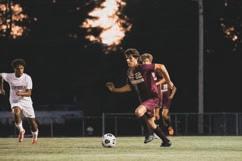HARBINGER The
FALL 2022: LEARNING FROM THE PAST
The Student Newspaper of Algonquin Regional High School
TITLE IX: FIFTY YEARS LATER





The Student Newspaper of Algonquin Regional High School




Title IX of the Education Amendments was signed into law 50 years ago, in 1972, greatly altering the way sports operated nationally, including at Algonquin. Its aim was to ban sex-based discrimination in sports and set a precedent for gender equality in athletics. We encourage students and community members to reflect on its positive impacts as a way to remember and honor this historic legislation while also identifying progress that still needs to be made for all people, regardless of gender, to participate in sports and be equally supported by fans.



In perhaps its most well-known effect, Title IX gave women more opportunities in sports from high school to the professional level. These opportunities transformed athletics, as well as creating the lasting outcome of increased participation in previously underrepresented female sports. And while Title IX certainly focuses on women in sports, the act has also been used in recent years to advocate for transgender student athletes, as recently declared by the U.S. Department of Education.
But Title IX did not just affect sports; its impacts affect federally-funded curricular and extracurricular activities as well. It increased education opportunities, to the extent that women now account for nearly 60 percent of enrolled students at college as
compared with the 43 percent of college students being women 50 years ago. In the context of the 1970s when the act was passed, it was common for girls to attend home economics class while the boys were sent to shop class. However, the passing of Title IX prevents gender bias in other school programs not explicitly listed in the legislation. We should no longer think of such activities as gender-specific, but rather embrace the opportunities for us to be thought of as individuals despite differences in sex and take any classes or do any activities we are interested in.
Most importantly, Title IX provides equal possibilities for both genders, despite being commonly depicted as a law solely affecting women. That being said, we can view this act as a means of appreciating and supporting each and every individual at Algonquin, regardless of gender. As we transition to the winter sports season, we urge you to support both girls’ and boys’ sports, and to attend games whenever possible.
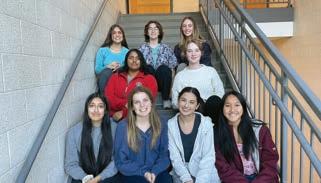
PRINT EDITORS
SOPHIA MURRAY Editor-in-Chief
JULA UTZSCHNEIDER Editor-in-Chief
RIYA MAHANTA Managing Editor
KATHERINE WU Online Editor
PRIYA MARALIGA Photo Editor
KATY O’CONNELL Photo Editor
ELLIE O’CONNOR News Editor
ZOE MANOUSOS A&E Editor
AVA ARCONA Assistant News Editor
SAHANA SIVARAJAN Business Manager
EDITORS
JOCELINE GIRON Multimedia Editor
MARYGRACE SARRASIN News Editor
AMELIA SINCLAIR News Editor
JEFFREY DRATCH Opinion Editor
ASSISTANT EDITORS
LUKE UTZSCHNEIDER Online
CAROLINE MACAULAY News
GRACE BOUZAN Sports
ANANYA PANDIT A&E
KATE MICHEL A&E
LILA SHIELDS Opinion
ARIELLE CHIN Opinion
The Harbinger strives to: Report in a legal, objective, accurate and ethical manner; Be fair and impartial in its coverage;
Accurately portray the culture of the student body; Give voice to the students of Algonquin; Entertain and start conversation; Maintain professional standards
CJ Bourbeau, Joe Lamburn, Owen Jones
Lili Torres, Jaclyn Faulconer, Niamh O’Sullivan, Vivian Simopoulos, Natalo Maggiolino, Satoshi Conway, Cass Melo, Jasmine Yee, Sophie Hjerpe, Adrian Mathew, Emily Harmon, Andrew Hodge, Hanne Brabander, Hannah Albers, Kelvin Crispo, Sophia Lalau, Kartiki Sarangdhar, Danny Schanzer, Colin Kearney, Ava Ellis, Lillian Johnson, Anna Bellville, Betsy Bertonazzi, Sophia Khan, Ela Or, Dayeon Lee, Caroline Lou, Linda Hu, Meredith Wu, Karma Bebawy, Sania Hasan, Grace Herdman, Tamara Tymoshevska
Lindsay Coppens & Michelle Sheppard
The Harbinger is the official news publication produced by Algonquin Regional High School students. The Harbinger has been established as a designated public forum to inform readers as well as for the discussion of issues of concern to their audience. The Harbinger is not reviewed or restrained by school officials prior to publication or distribution.
Because school officials do not engage in prior review, and the content of The Harbinger is determined by and reflects only the views of the student staff, its editorial board assumes complete legal liability for the content of its publication.
The expression of opinions by readers is encouraged through letters to the editor. Letters should not exceed 300 words, must be signed, and must include the writer’s phone number for verification. Letters may be submitted to arhsharbinger@gmail.com.
Organizations interested in advertising in The Harbinger should contact editors for rates and policies. Advertising that appears in the publication is not necessarily endorsed by The Harbinger or its staff members. Concerns about published errors may be submitted to arhsharbinger@gmail.com. Staff members strive to correct errors prior to publication; however, if a significant error is printed, editors will determine the manner of a correction.
Typography and layout are done entirely by the staff which distributes approximately 1,500 copies to the school community, paid subscribers and advertisers. The Harbinger is printed by School Paper Express.
The Harbinger is affilliated with The New England Scholastic Press Association, The Columbia Scholastic Press Association and The National Scholastic Press Association.
21
14
REMEMBERING JON NIEMI Q&A WITH BEVAN
16
06 10 22 28
TITLE IX
A look back at how the past 50 years have changed Algonquin athletics

Pledge of Allegiance, Algonquin blocking websites, varisty sports, wearing masks, revisions on tests

NEWS PROFILES
phone policies, Q&A with Bevan, bus shortages, Title IX, Jon Niemi
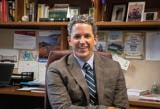
new teachers, class presidents, new clubs
ARTS & ENTERTAINMENT
Story Bridge, False Prophecy band, Guys & Dolls, playlist, reviews, blogs
38 SPORTS
new mascot, cross country, girls’ soccer, girls’ volleyball, boys’ golf, look back on fall sports
 JEFFREY DRATCH Opinion Editor
JEFFREY DRATCH Opinion Editor
Since the late 1800s, the Pledge of Allegiance has been a staple in American public schools, and American culture in general. For many people, including the majority of Algonquin students, the pledge is simply a part of the beginning of the school day. However, many people fail to recognize the truly hideous past that the pledge traces to its roots.
The Pledge of Allegiance began in Massachusetts, crafted by former pastor Francis Bellamy to create greater patriotism and American legacy. The forming of the pledge led to American flags being placed in virtually every public school classroom, in addition to the speech being recited daily over announcements. The pledge’s inception certainly did what it was supposed to, creating greater pride for Americans.
What most individuals don’t realize is the problematic history behind the pledge, with a long past of xenophobia, white nationalism (the belief that white people are superior to all other racial or ethnic groups) and blatant racism. The earliest adopters of the pledge were mostly wealthy white elitists, who were extremely privileged and some of the few to have access to good education. According to a Washington Post article showing the discrimination present behind the pledge, Francis Bellamy sought to “define true Americanism” against the rising tide of southern and eastern European immigrants “pouring over our country.”
Bellamy was essentially expressing that a large influx of immigrants, especially from nations in eastern Europe, didn’t belong. The pledge led to alienation of Jewish individuals, people of color and immigrants. Decades of racial segregation in schools led to non-white individuals as well as immigrants, feeling as if they don’t belong. However, over 130 years after the creation of the original pledge of allegiance, this dark and frankly disgusting past has been severely washed over.
Most educators and enforcers of the pledge don’t know the background carried with it, as well as students. However, according to a Massachusetts law, even though students can not be forced to recite the pledge, the law states that “Each teacher at the commencement of the first class of each day in all grades in all public schools shall lead the class in a group recitation of the ”Pledge of Allegiance to the Flag”. Additionally, schools must have an American flag hung up in every classroom, with a flag also hung up in front of the school, every day of the school year.
During my first period class every day, a student
council member picks up the phone and recites the Pledge of Allegiance to the entirety of the Algonquin community. I look around the classroom and the overwhelming majority are standing up, reciting the 31 word speech with their hand over their heart.
After realizing the past behind the pledge and feeling extremely frustrated with the pressing injustices in America, I have made the personal decision since fall of 2019 to sit down while others stand and recite the speech. I think it is important to acknowledge the reasons one might sit during the pledge, and respect their decision to do so.
For schools such as Algonquin trying to create an environment of equality and justice, promoting the Pledge of Allegiance with its dark history disagrees with this essence of equality. While the right to not participate in the Pledge of Allegiance is protected under the Supreme Court decision in the case Cantwell v. Connecticut, there is still significant social pressure to conform. Something so outdated, and fairly religiously based by including “under god,” violates the Freedom of Religion First Amendment right and should be eliminated by our state government and the federal government to show minorities that their own country loves them.
The Pledge of Allegiance holds a big part of American history, and is still recited by millions every day. However, with societal issues impacting daily life for millions of Americans, reciting this speech counteracts with many social improvements in the United States. Until state and federal laws change, as in-
dividuals, consider the history behind the pledge before you choose to recite it, and use your power as Americans to change legislation surrounding the Pledge.
All students, faculty, administrators and community members should embrace the idea that diversity is crucial in schools along with believing that academic excellence depends on a diverse faculty. If both adults and children make it their mission to cultivate inclusion and celebrate diversity, we can become an even more inclusive school where every student thrives.
This article was published in Oct. 2022 on arhsharbinger.com.
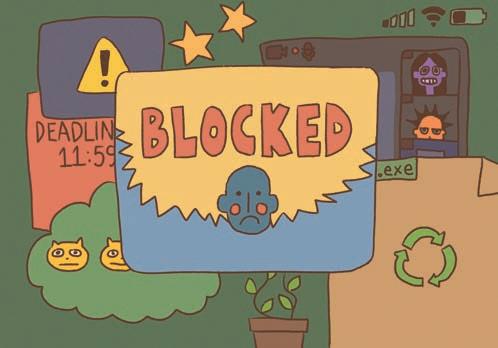 AVA ARCONA
Assistant News Editor
AVA ARCONA
Assistant News Editor
Since the beginning of the school year, Algonquin students and teachers have had to work around the new restrictions set on the websites able to be visited using school devices or when connected to school Wi-Fi. This update, while at best a minor inconvenience, has become a hindrance to the learning process and disproportionately affects those who borrow a device year-round.
The need for technology has been steadily rising since the start of the pandemic; teachers and students alike have become more reliant than ever on applications like Canvas and AP Classroom to stay up to date with assignments and keep their academic lives running smoothly. With the use of computers and phones during school hours becoming increasingly common, it is completely understandable to set boundaries on what sites can and cannot be visited in order to prevent distraction.
However, some of these limits serve little to no purpose, especially those set on school-owned devices. Prohibited services on school-issued Chromebooks include: Google Lens (reverse image search-
ing), the addition of any Chrome extension, as well as accessing all system settings. This includes printer controls, advanced Wi-Fi and Bluetooth settings, and downloading apps on the Google Play store.
In addition, publications such as US News, Vox and Wired are all blocked on the school server, a clear limitation of students’ ability to stay up to date on current events or utilize relevant articles for academic purposes.
Some useful sites were seemingly blocked at random, including TIME Magazine and Psychology Today, likely the result of broad filters applied to certain types of web addresses. The effects are noticeable; essentially every student has run into the “Blocked by administrator” message while working on a research project or completing assigned work.
Another issue arises when you take into account that many students rely on school-owned Chromebooks for personal use, having no alternative device available for use at home.
These students, myself included, are granted access to only the most basic sites and services even after the school day has ended. Although the devices are school-owned, more leeway should be given outside of school hours to those who require it for
homework, their job or out-of-school hobbies. Having ample access to the Internet and technology at school is a privilege not guaranteed to every student in our country; with that being said, there is room for improvement within the current system utilized by Algonquin.
Some regulation is necessary in order to maximize productivity and avoid content unsuitable for school, but restricted materials should be chosen deliberately to avoid sweeping harmless websites under the label of “inappropriate.”
This article was published in Nov. 2022 on arhsharbinger.com.
One of my favorite tropes in cheesy high school rom-coms is that of the popular jock who discovers a passion for the arts, a la High School Musical, in which said jock embarks on a journey of self-discovery as he grapples with the two sides of himself. Aside from public school students breaking out into perfectly synchronized musical numbers, I can’t help but notice another major difference between Troy’s experience and that of the typical high school athlete: the sheer impossibility of balancing a varsity sport with another long-term commitment.
The average varsity athlete spends about 13 hours per week on the court, assuming they attend two hour practices after school and compete in two games or meets weekly, each lasting about 90 minutes. This excludes travel time and waiting for the JV teams to finish playing for some sports, which can add hours to the process. Practice usually starts around 3:00, allowing minimal time for club meetings or extra help with a teacher on non-game days.
If an athlete misses practice for an equally import-
ant commitment, they may end up being benched or otherwise punished by a coach. If the same athlete fails to fully complete their homework because they were scheduled to work or watch their siblings after practice, their grades will suffer.
Sports of any level are an incredibly important part of the high school experience; the issue arises when they become a source of stress instead of a break from it. Aside from pressure to perform, athletes often fall victim to physical injuries or lack of sleep during the season, all of which can affect their academic performance and overall mental wellbeing. Students are also expected to sacrifice much of their social life in order to keep up with the other aspects of high school.
My personal experience with sports at Algonquin has been overwhelmingly positive, as is the case with many of my peers. The issue remains, however, that many students have been left with no choice but to give up one or more of their interests in order to continue their career as an athlete.
This problem is not unique to our school district—according to the NCAA, student athletes are more likely to burn out than peers who opted out of sports. High school is meant to be a time in which
teens are free to explore their options and interests, with relatively low stakes in comparison to a college environment.
As students make the transition to high school and become accustomed to a stricter schedule, it is expected that a few sacrifices be made in order to balance their workload with extracurriculars. One of my favorite aspects of our school community is that students here are encouraged to try different activities and venture outside of their comfort zone, but this becomes exponentially more complicated when a sports commitment is thrown into the mix.
In general, high school students tend to overcommit in order to keep up with the expectations set by colleges or their environment. Athletes, I commend you for your dedication and all the hard work it’s taken to get you to this point. Remember to give yourself breaks when needed, and to try something new if it interests you during the off season.
This article was published in Sept. 2022 on arhsharbinger.com.
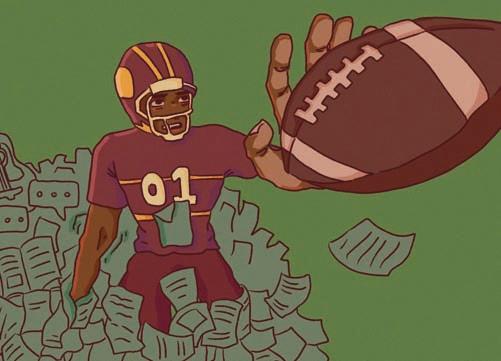
 LILA
LILA
As a result of the COVID-19 pandemic, many individuals have become accustomed to wearing masks, hoping to protect their health by covering their face. For a time, it was mandatory to wear a mask in public spaces, and though this ensured safety, it has also sparked insecurities.
Having a mask felt like an invisible cloak for some, hiding their “flaws” and expressions. Masks have grown to become a blessing and a curse; some wear them solely for safety, but also to conceal parts of themselves.
According to The CDC, masks are scientifically proven to provide protection from disease, and now more than ever, they encourage people to wear masks while physically ill.
The increase of internet use has not been a help. Trends have sparked where people rate their features or shame their side profiles, especially after the recent rise of social media platforms centered around beauty and comparison. The standard to have a small nose and big lips is not only unrealistic but dangerous, as people have gone to extremes to reach this appearance. In the February 2016
article “Annual plastic surgery statistics reflect the changing face of plastic surgery” from Science Daily, plastic surgeries have increased 115% since 2000, more and more people are normalizing these serious procedures leading to teenagers counting down the days until they are 18 and eligible for operation (without parental permission). Low confidence has spread to others who feel embarrassed or even ashamed of their features, leading them to cover up with a mask.
In the May 2021 article “The people who want to keep masking: ‘It’s like an invisibility cloak’” from The Guardian, some people who work in customer service oriented jobs have expressed the feeling of safety while wearing a mask. Wearing a mask is known to cover your smile, which lowers passive-aggressive comments towards employees, including the ever-famous “you would look prettier if you smiled.” In general, masks have allowed people to rest their faces comfortably without the fear of being judged, belittled and having people get the wrong impression.
Not to mention, face masks can cause acne, referred to as “maskne” by some, especially on sensitive skin. Cleveland Clinic has dove further in depth revolving around why masks can cause skin irritation. This has not only led to a never-ending cycle of
masks covering insecurities, but also being a cause of them.
Luckily, masks have created an effective way to save lives, though it has also led people to rely on wearing a mask to hide their faces. Small insecurities have since turned into bigger ones.
People worldwide have used masks as a way to hide their face as well as ease social anxieties, though becoming overly reliant on anything can negatively impact one’s life.
This article was published in Oct. 2022 on arhsharbinger.com.
For many students, the opportunity to be able to revise tests and quizzes would benefit learning because various factors such as stress, sleep deprivation from studying all night or even having the occasional brain lapse can impact how well they score on tests. If a student received a score that doesn’t accurately reflect their acquired knowledge and skills, they should be allowed retakes in order to prove that they do fully understand the material.
In the 2020 Education Week article “Why Should We Allow Students to Retake Assessments?”, the idea of assessment retakes highlights the importance of allowing students a second chance to demonstrate their mastery. When students are given the opportunity to retake assessments, which typically contribute to a high percentage of their overall grade, they are more likely to achieve a higher grade as they can see where they need to improve and work on those problems.
However, many teachers around the nation are hesitant to give retakes due to numerous reasons. Some say they don’t have time to schedule a retake for students or to create an alternate retake test. Others believe that if you give students a second
chance, you are not preparing them for real life where second chances are not as frequent. While this argument is valid, during their academic careers in high school, students should be rewarded for learning from their mistakes by getting a boost in their grades because they worked hard to improve their weaknesses.
While even without points for revisions it would be ideal for students to take the initiative to review their missed questions and seek extra help in the areas they struggle in to better them understand what they got wrong, applying what they learned from those mistakes into revisions would be an extra benefit.
Students also need to meet their teachers halfway by taking the responsibility to understand their mistakes by reviewing the questions they missed and using their mistakes as the next step in the learning journey, whether or not revisions are offered.
It is important to mention that the scores and grades students receive on tests and quizzes do not always equal how good of a student they are or even how intelligent they are, even if this fact can be hard to accept. Grades students earn on tests and quizzes are only a mere reflection of how well they performed on that day, and are not always an accurate reflection of their knowledge in that subject matter.
When students can let go of the fact that grades are the only one determining factor of their success, they can truly begin to dive deeper into their learning by accepting failure as a step in the process of gaining success.
According to a 2019 article by Edutopia, “Allowing Test Retakes - Without Getting Gamed,” that included educational and learning strategies, mastery quizzes and reflective test corrections are two methods they highlight that could prove to be useful in classrooms around the nation. Mastery quizzes include creating a small assessment solely based on the questions that a high percentage of students got wrong while reflective test corrections can include a survey or even a questionnaire that asks students to explain why they got a certain question wrong and show the correct way of approaching and tackling the problem at hand.
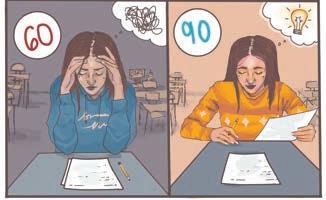

When students get the opportunity to reinforce their weak spots in certain areas of a subject through methods such as these, they can be more engaged in their learning and begin taking greater strides towards success.
This article was published in Nov. 2022 on arhsharbinger.com.
The way world language is taught in the US needs to be overhauled by Jeffrey Dratch
Let your voice be heard by Harbinger Editorial Board
Pretty privilege bias is real, harms individuals by Arielle Chin
Going vegan is a privilege by Lila Shields
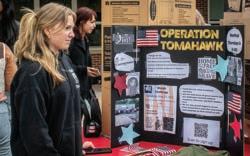
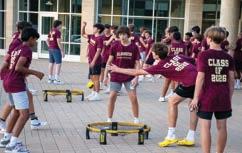

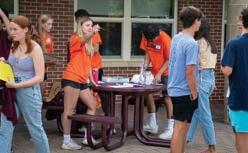


With the 2022-23 school year in full swing, students and staff are becoming accustomed to an overall stricter attitude regarding the use of electronics, namely cell phones and earbuds, during school hours.
At the beginning of the first term, Algonquin students gathered at their respective class meetings for a presentation outlining several updates and reminders regarding school policy. These include the prohibition of headphones in the hallways while class is in session, regulation of phone use based on each individual teacher, as well as newly implemented consequences for a repeated offense.
Principal Sean Bevan believes that while technology can be beneficial in some instances, these reminders of existing policy contribute to the overall quality of students’ education.
“The boundary for when the use of technology was appropriate and when it was impeding [students’] learning was getting blurred,” Bevan said. “We’re trying to create more clarity around those boundaries, with the goal simply being about teaching and learning.”
During previous years, existing policies regarding phone use were seldom enforced on the administrative level, instead being dictated by teachers. Students were often able to use their devices freely
in class, including listening to music through head
phones. Bevan links the dependence on these devices to the COVID-19 pandemic, a time in which technology was the only way of staying connected with peers.
“Coming out of the pandemic, students had this understandable reliance on technology, having spent two years apart from each other,” Bevan said. “We want to try to signal to them that there are good, safe, appropriate places for [using technology].”
Bevan shared the results of an informal survey he gave teachers at the beginning of the school year, asking about the impact of cell phone and headphone usage in their classrooms during the 2021-22 school year. Responding using a one to six scale, of the 87 respondents, 38% selected “six,” indicating the problem was “very large” with only 5% selecting “one,” indicating phones and headphones were “no problem at all, students only use them with my permission.” Five percent of teachers rated classroom use of phones as a “two,” 10% as a “three,” 22% as a “four” and 21% as a “five.”
According to the Student Handbook, cell phone usage is permitted only during unstructured periods, such as passing time and lunch, and during class time if explicitly instructed by an adult. By putting an emphasis on staying focused in class, Bevan hopes the learning experience will be smoother and more effective for both students and teachers.
“Every teacher is using some type of strategy,”
Bevan said. “There’s very few, if any, earbuds during instruction, which last year I saw quite a bit of.”
This re-definition of existing policy originated in widespread concern among teachers about the level of attention spent on phones during class, rather than all focus being on the lesson. Like Bevan, English teacher Emily Philbin noticed the issue became more prevalent during and directly after the period of remote learning.
The teachers were really frustrated by the phone use the past few years,” Philbin said. “Our shift to more technology [since the pandemic] has led to more distractions.”
After experiencing the phone use epidemic firsthand, Philbin came to a simple solution for how to eliminate any potential distraction in her classes.
“I had decided, before we even had a meeting, that this year I was going device-free with all my classes,” Philbin said.
Philbin believes mutual respect is critical in the student-teacher relationship. She asserts that in order to fulfill her role as an instructor, it is essential that each student value the time they spend together in class.
“I used to just ignore the phone, and [hope] it goes okay, but it also bothers me,” Philbin said. “It’s my job to make sure that you are getting this information–there’s responsibility on both sides.”
When it comes to listening to music during class, Philbin sees it as a useful tool only when blocking
out noise in order to focus. She cites research on the topic to emphasize the impossibility of internalizing a lesson while listening to music.
“What’s important for students to realize is that your brain is processing language,” Philbin said. “If I’m talking to you and you’re listening to something, your brain has to choose what to [process].”
Bevan surveyed teachers again on Oct. 17 about cell phone and headphone usage in their classrooms. Using the same scale of one to six, of the 83 respondents, 2% selected “six,” indicating the problem was “very large,” and 10% selected “one,” indicating phones and headphones were “no problem at all, students only use them with my permission.” Forty-one percent of teachers rated classroom use of phones as a “two,” 25% as a “three,” 17% as a “four” and 5% as a “five.”
Although the survey results indicate that most teachers have experienced positive changes in their classrooms due to the reinforced policies, some returning Algonquin students had difficulty adjusting to a new environment. Having attended the school before the COVID-19 pandemic, senior Hannah Albers observed that the rules for phone usage this year are the most strict she has experienced so far.
“Specifically this year, I’ve noticed a lot more teachers have brought up cell phones, teachers that I’d had in the past that wouldn’t really mind,” Albers said. “More teachers have been enforcing rules [regarding phone use].”
“I think it’s good that teachers don’t let students be on their phones all the time, but I also feel like it’s not necessary to take them away. It is your property so I don’t think teachers should be able to take it.”
Albers understands the purpose of the reinforced policies, but simultaneously believes that they set unrealistic precedents for her future education. She points out that members of the senior class should be prepared to make their own academic decisions, should they choose to attend college.


“Having the option of your phone being out gives you a responsibility,” Albers said. “No professor is going to take your phone away.”
Junior Patrick Biamou has a similar opinion when it comes to the responsibility of high school students, many of whom are close to adulthood, in relation to the use of headphones.

“I think it should be a student’s choice… because it’s our education,” Biamou said. “I feel like I’m more present when I’m listening to music; it keeps me awake.”
The regulation of technology and the effort to eliminate classroom distractions continues to affect all members of the community. Given the approaches taken by administrators and teachers going into the 2022-23 school year, students should be prepared for these policies to be maintained for the duration of their high school career.
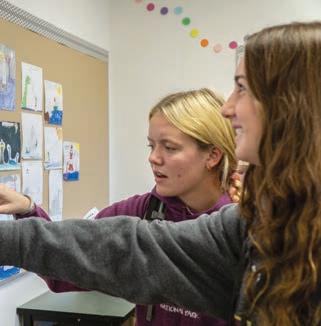
“Our short-term goal this year is to primarily communicate to students that the idea of being present is really important,” Bevan said. “That when they’re in class, they’re really present; they’re not using earbuds or cell phones.”
“I am not a fan of the cell phone policy. I think that we should be allowed to use our phones in the hallway.”
Adam Guggina, junior
“I think they’re fine. I don’t really follow them. Nobody really does. But the wifi is terrible and is a bigger blocker of cell phone use than the policies.”
As the 2022-2023 school year was getting into full swing, Principal Sean Bevan reflected on his goals for the year, as well as addressed recent concerns from students and staff.

What are some of the most important things you and your team want to work on this year?
“Usually most years we set some long-term and short-term goals. Our short term goals this year are to primarily communicate to students the idea of being present, which is really important. Part of that is their daily classroom attendance. We still want to make sure kids aren’t coming in when they’re sick, we don’t want that. We want to make sure that parents and students understand the number one predictor of students’ high achievement is whether or not they’ve got good attendance.”
One of the things staff is excited for, and that I’m excited about, is that we’re really going to be talking more about instruction. In the last two years we’ve talked a lot about social distancing and hybrid instruction, and then distance learning, all these really artificial constraints on the learning environment. This year, we’re going to be talking about lesson planning, grading and things that are probably as applicable 20 years ago as they are today. We’re getting back to the basics of education after two and a half years of really having to be forced away from that.”
What are you most looking forward to for this school year?
“Since I’ve been here, this is the first year that is mostly a normal year in a lot of ways. I came in as principal in July of 2020, so that was a time where we were right in the heart of the pandemic, and even last year which seems so distant, we had a lot of disrupted elements of our school environment. So this was a year I was feeling like it would be a more normal experience and that’s what I’m looking forward to, normal. Just ordinary things and, as ordinary as they are, they are important things.”
There have been some concerns from students about the new technology and phone policies. Why do you feel as though they are important or aid in the learning process?
“I want to make clear that I think there are very appropriate ways that technology can be used in class, and I think that if I were a teacher in 2022, I’d probably have opportunities in any given week, certainly, and in any given lesson where there would be an opportunity for a kid to use technology. I think what was happening was the boundaries for when that technology use was appropriate and when it was just impeding their learning was getting kind of blurred. We’re trying to create more clarity around those boundaries, with the goal simply being about teaching and learning.”
There has been a lot of discussion about the WIFI and technology issues at our school currently. How do you feel about the frustrations with technology?
“I’m going to start off by saying that in the year 2022, technology is so critical for instruction and for learning. …It’s important that we have strong and reliable wireless [internet], and that all the other elements of our technology work. … As I un-
derstand it, we made some enhancements to our wireless network that strengthened and made our wireless network more secure, but there have been some hiccups in implementing that properly. Putting staff on one band of wireless was one element of it, and students and guests had other networks. There were some improvements, but I think right now we’re ironing out the wrinkles of how those improvements are actually being experienced by kids as friction points.”
What do you think students and teachers should be most excited about this year?
“We are back. I haven’t been back at Algonquin in a regular year since when I was a teacher, so I think it’s an opportunity to reestablish those old norms and traditions and exciting events, things like the Winter Ball, for example, and maybe even invent new ones. So I think something like the outdoor lunch, which we invented to give kids more space to eat during the pandemic. That’s staying around because kids seem to enjoy it and it feels like it improves the crowding, or addresses the crowding in the lunchroom. It’s just the kind of thing that I feel will be around for a very long time. We’re building on the challenges of the pandemic, and the innovations we applied from there, and keeping those, and then reinstituting the things we know kids really enjoy.”
This article was published in September 2022 on arhsharbinger.com.
Q&A: Bevan reflects on priorities, responds to concerns for 2022-2023 school year
Students across the Northborough-Southborough District have been impacted by frequent bus route cancellations and delays, a consequence of the nationwide bus driver shortage.

According to Assistant Superintendent of Operations Keith Lavoie, the district has a three-year contract with North Reading Transportation (NRT) that is set to expire in the spring of 2023. The program costs $2 million each year and originally involved 32 drivers. However, this school year the district was limited to 29 drivers, which has led to combined bus routes and cancellations when there is unavailability.
Students have expressed worries about the cancellations, which have often been announced right before school ends or begins. This can provide challenges for students if they have little time to find an alternative. Over 10 morning and afternoon bus routes have been canceled or delayed since September. Lavoie attributes this issue to the nationwide bus driver shortage, a reflection of the overall American labor shortages.
“The bus driver shortage is really what’s driving this, and we also don’t know [about a cancellation] until maybe an hour before the start of the day or dismissal, and then you have to make a tough decision,” Lavoie said. “Typically our bus company would have substitute drivers ready to go on a daily basis, but now every day, we need at least three drivers to substitute certain routes, and it’s not consistent.“
Algonquin has not been alone in these challenges. According to a July 2022 Bloomberg Article, “America’s Bus Driver Shortage Has Left Transit Systems In Crisis,” a recent survey conducted by the American Public Transportation Association reports that 71%
of 117 participating transit agencies had to limit service increases or cut some services altogether.
The bussing issues are not just limited to students commuting to and from school. Student athletes have also felt the impacts, with sports games and meets being canceled or postponed from a lack of bus drivers. Athletic Director Mike Mocerino described the uncertain situation when he was interviewed for the Harbinger in October.
“[The busing situation is] challenging, frustrating, difficult,” Mocerino said via email. “[The Athletic Department is in] constant communication with the coaches, athletes, and families, adjusting the schedule, and/or implementing private transportation when needed.”
High school and middle school routes are not the priority for bus transportation, which can result in more cancellations for ARHS students.
“Unfortunately [the district] will cancel an Algonquin bus before we would cancel an elementary school bus,” Lavoie said. “We have to put our resources to the younger kids because our high school kids typically have more options available. And while that is not fair to high school kids, that is the reality.”
The district has made efforts to help students when there is a cancellation, such as notifying teachers so that there are no attendance repercussions. Lavoie values the dedication shown by the district’s bus drivers, who have improvised when sudden changes to bus routes are necessary.
“I wouldn’t say that [the cancellations] have happened a lot, and I think we’ve avoided it because our drivers have been very committed,” Lavoie said. “A lot of the drivers have taken additional stops, or
they’ve taken additional routes, and that has really helped us which has been great.”
However, potential changes with NRT may result in improvements, such as a decrease in cancellations and delays.
“I’m pretty optimistic,” Lavoie said. “I think that NRT has been able to get a couple more drivers to commit. They are training more people to be drivers so that we can, at minimum, get all of our drivers back.”
Despite the difficult situation, Lavoie appreciates the cooperation of Northborough and Southborough families.
“I have seen that people have been incredibly patient, and they have been actually incredibly supportive,” Lavoie said. “People are frustrated by it, but they’re taking it in stride and hoping that it improves.”
Today, whether playing on a girls’ or boys’ team, Algonquin athletes wear their Titan uniforms with pride, putting in long hours on the field, court, track or mat, competing at the top level and striving for State Championships. However, flipping through yearbooks from the 1960s and 1970s shows another story. There were significantly fewer girls’ teams than boys’. Not only did uniforms look different, with many of the girls wearing skirts, but as athletes from the 1960s say, the focus for girls was less on competition and more on just having fun. That all began to change fifty years ago in 1972.
In June 1972, President Nixon signed Title IX into law, which, prohibited discrimination on the basis of sex in education and athletic programs. This law changed female athletics at Algonquin forever.
Today, 50 years later, Algonquin has 16 varsity girls’ sports teams and in the years since Title IX went into effect, girls’ teams have won a total of 10 State Championships. However, change wasn’t immediate. The history of women’s athletics at Algonquin is extensive and complex.
When Title IX was first signed into legislation, Algonquin offered more sports for girls than many other area high schools. However, the only sports offered for girls at ARHS were field hockey, basketball, cheerleading, softball and tennis. Although there was boys’ hockey, track and golf, these weren’t options for girls. In fact, girls’ hockey, which won the State Championship in 2022, became a varsity sport in 2003 and girls’ golf in 2017. Both teams are currently collaboratives with area schools.
Class of 1971 alumna Patti Fouracre Serafin played field hockey, basketball and softball at Algonquin. She remembers not only were there fewer sports, but some sports, such as basketball, were played with significantly different rules.

“When I started playing basketball my freshman and sophomore years, the girls didn’t play like the boys played,” Serafin said. “The boys played with five players running up and down the court while we played with a six player formation and many different rules; there was an offensive and defensive
end and depending on your position, you could only stay on one side, with two rovers that could play on both sides.”
Class of 1962 alumna and member of Algonquin’s sports Hall of Fame Stephanie Slack, who played field hockey, basketball and softball at Algonquin, recalls that boys’ teams were allowed to practice on the gameday court significantly more than the girls’ team.
“The one gym that we played our games in was pretty much dominantly used by the boys’ team,” Slack said. “We could only get on the gameday court every once in a while, and when we did they boys’ team made it seem like they were doing us a big favor.”
However in 1971, even before Title IX went into law, girls’ basketball switched to the same five vs.
five formation as the boys’ team and were undefeated, with a record of 12-0, winning the title of Midland League Champions.
“Our senior year, the team was invited to a tournament, and not very many teams prior to us went to the tournament,” Serafin said. “It was the Southbridge High School Girls’ invitational tournament, and the first round was a bye due to our impressive undefeated record; however, we were defeated in the second round.”
Serafin remembers discrepancies between playing conditions and fields for baseball and softball as well, which impacted and limited fans.
“For baseball, there were bleachers for the fans but for softball there were no bleachers, not even a little portable set of bleachers; people would have to bring their own chairs,” Serafin said.
At Algonquin now, both the baseball and softball diamonds have bleachers for fans and viewers to watch.
Another difference that impacted fans and gave priority to boys’ teams, was the timing of girls’ and boys’ games; however, now they occur at similar times.
“The boys played at night and the girls played right after school,” Serafin said. “The majority of people attending a girls’ game would be parents or friends, not like the general population of the student body like when you went out to a boys’ game, which had the pep club people that would sit up in the stands.”
Although boys and girls athletics weren’t entirely equal before Title IX was passed, Slack says Al-
gonquin was progressive compared to neighboring schools.
“We were lucky at Algonquin; we were really ahead,” Slack said. “We had good uniforms, we had good equipment and we had a coach that advocated for us and got us games and transportation and officials. Algonquin really put some value on girls athletics, certainly not how it is today though. When I left Algonquin after seeing some other programs at other schools, I realized that Algonquin really did a good job before Title IX that didn’t technically have to be done.”
Athletic Director Mike Mocerino, who was an ARHS athlete and coach, believes the school has done a good job in providing equal athletic opportunities for girls and boys.

“As a former student-athlete from 1996-2000, and then coach from 2006-2017, I believe Algonquin has gone above and beyond to ensure that both genders have equal opportunities through interscholastic athletics,” Mocerino said. “Today, we offer up to 58 total sports teams, most with three levels depending on the sport and participation numbers. We offer 16 sports for our boys and 16 sports for girls. And, even though high school girls’ participation in athletics has grown, there is still room to grow.”
In the 1960s and 1970s, many girls went into high school with little experience in sports, oftentimes not playing a sport until high school.
“One of the things about growing up in Northborough was that there wasn’t anything for girls before
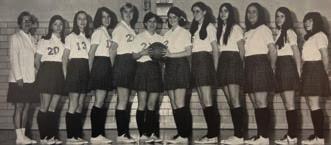
Gymnastics 1994
you got to high school,” class of 1971 alumna Janet Faucher Cooley, who played field hockey, basketball and softball at Algonquin, said.
According to Serafin, virtually everything started for girls athletically in high school.
“There were no community sports like Little League for boys,” Serafin said. “The closest thing we had to a community based sport was when Father Cahill at St. Rose of Lima came and started a lassie league, which was like slow-pitched softball, in junior high. We wore denim pants and white blouses, called dungarees, and we didn’t know who was on what team because everyone wore the same uniform.”
Girls’ Varsity
Tennis 2009
Now, there are a myriad of intramural sports opportunities available for young girls, so many athletes come into high school experienced.
Girls’ Varsity
Soccer 2009
“I think it was great to watch the progress of it [female athletics] evolve into more,” class of 1970 alumna Rosemary McGowan said. “The great thing is as kids went into college and were good at their sport, it opened up doors for anybody to have it be equal.”
When McGowan was in high school and played field hockey, she noticed that people displayed a different attitude towards girls’ and boys’ sports.
Girls’ Varsity
Gymnastics 2011
“There really wasn’t much emphasis being a female on a sports team,” McGowan said. “They were not recognized as they are now. My great niece was a very good softball player and everybody knew, but I don’t think anyone knew, outside the softball team and coaches, that we were part of a sports team. If you were on the football team, everyone knew.”
Girls’ Varsity
Gymnastics 2012
Girls’ Varsity
Hockey 2022
Girls MYRO State Champions
Girls’ Varsity
Rugby 2011-2015
According to McGowan, athletics then were treated as after school clubs rather than varsity sports.
“We didn’t know better than that it was an after school activity, our expectations at that time weren’t that we should have more people there,” McGowan said.
Due to Title IX, sports are taken more seriously now, leading to more opportunities for women to compete beyond high school.
“Title IX opens doors for women,” McGowan said. “So many years later, I saw what it did for my [great] niece, who got a scholarship to college for pitching.
It was wonderful to see.”
Another factor that contributes to the success of
female athletes in high school to ultimately play at the collegiate level is the increase of resources and programs.
“Nowadays, athletes have conditioning classes before their sports season, are in the gym working out, going to clinics, have private coaches and athletic trainers,” Serafin said. “We didn’t have any of that. We just showed up and played, it was not as rigorous as today’s women’s sports are.”
Slack began coaching field hockey, fencing and softball in 1969 at Milford High School, before Title IX was passed.

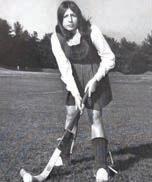
“Milford virtually had nothing, no PE class for girls at all, so when I took the job I agreed to start a PE and field hockey program,” Slack said. “The girls didn’t know what field hockey was, we didn’t have a field and only had some equipment. I had to beg for everything, from uniforms to equipment. I can remember drawing lines in the dirt to coach the field hockey team. Title IX was passed, and all of a sudden things started to develop much more quickly, including coaching salaries.”
According to Slack, Title IX caused mixed feelings in the school, with some people concerned about its impact on the boys’ teams.
“Men were a little worried that money was going to be taken out of the men’s program to help the women’s program, but that wasn’t the intent of Title IX at all,” Slack said. “It was to give women equal opportunity and equal services. It didn’t take away from any of the men’s programs, it just helped the women’s program so much.”
Once Title IX passed, Slack noticed her requests were taken more seriously.
“My requests were not elaborate because I knew I was going to have to fight for it, but after Title IX, if they were spending thousands on one boys’ team, they had to spend the same on the girls’ team,” Slack said. “It meant so much to us as coaches, because all of a sudden I had a right to ask for things, rather than wait to be granted something, like a gift or a favor. Before Title IX, for example, if I asked for four dozen field hockey balls, I might have gotten one dozen at best.”
After Title IX was passed, girls’ interests in participating in sports increased, leading to more teams being created.
“After Title IX was passed, some girls wanted to run track or cross country, and they included them on the boys’ team,” Slack said. “Eventually, after
Stephanie Slack passes the ball during a varsity game COURTESY 1961 YEARBOOK Rosemary McGowan, 1971. COURTESY YEARBOOK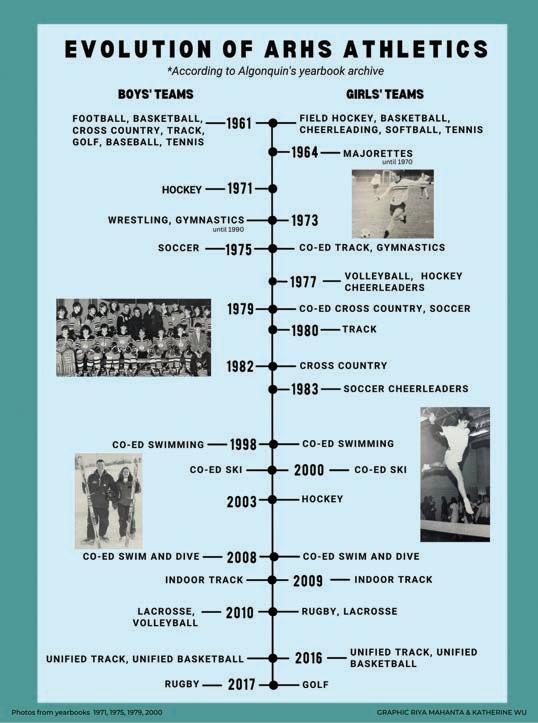
enough girls joined the boys’ team, they would make a girls’ team. Because legally no one could say no, they had to provide it if there was enough interest.”
However, oftentimes it took a while before a new girls’ team was formed at Algonquin, according to former Athletic Director Dick Walsh. Walsh was the AD when Title IX was passed.
“It wasn’t super quick to make a new girls’ sports team because a lot of the other schools did not have those girls’ sports yet,” Walsh said. “You can’t really have a team without opponents or a league; there had to be teams to play.”
In addition to affecting conditions on the field, Title IX changed dynamics inside classes as well.
“Before Title IX, boys and girls were never on the same side of the gym; that was not even thought about,” Walsh said. “After Title IX was passed, the gym classes were not separated anymore and girls and boys did the same activities.”
Serafin worked at NBC covering golf tournaments, but did not notice a significant difference in the workplace immediately after Title IX was passed.
“I did not really see an impact in the first couple of years since it had passed, money was certainly not raining down,” Serafin said.
Although Serafin didn’t see an impact in the first couple of years since Title IX passed, Slack believes
learn; you have to continue on, which is a terrific life lesson.”
Serafin agrees that playing sports was a valuable portion of the high school experience.
“I grew up in a house where the driveway was a basketball court and the backyard was the baseball and football field; there were sports being played at my house all the time,” Serafin said. “It gave me pride to be a part of a sports team, a team that represented our school.”
The teams created as a result of Title IX have built lifelong relationships, as McGowan stays in touch with her old teammates.
“I enjoy water skiing, and when I was almost in my 50s I played co-ed softball,” Serafin said. “Now, I get to watch my granddaughter play flag football.”
Access to women’s sports has also increased through television.
“I love to watch women’s sports, especially tennis and soccer,” McGowan said. “Back then, they did not televise women’s sports like they do now.”
Cooley was the first female Little League coach and Serafin was the first women’s coach for basketball in Northborough.
“I coached those boys when they were 5-6 years old to Babe Ruth,” Cooley said. “It is very rewarding to see the same boys hang out together and call me Mrs. C; you can’t even imagine how rewarding that would be, these are the community sports we didn’t have.”
In the 2020-2021 school year, ARHS had 596 male and 541 female student athletes, and in 20212022, there were 629 boys and 541 girls participating in sports.
“As you can see from the data, the impacts of many years of progress are considerable,” Mocerino said. “For example, our women’s ice hockey team won the program’s first-ever state title. The girls’ ice hockey team’s gritty, gutsy, joyful win was the culmination of a magical tournament run and of 50 years of progress for ARHS.”

its impact has strengthened and can be seen today.
“It certainly helped bring schools that were not up to standard to improve a lot,” Slack said. “As far as the schools are now, if they can’t comply, then parents and educators have a right to make them comply as far as making opportunities available for women.”
Title IX has enabled girls’ sports to impact many lives, as they mean more than exercise and winning; they build friendships and teach valuable life lessons.
“Being on a team, you learn compassion from each other and to support one another, and certainly can learn a lot from adversity,” Slack said. “You can either keep fighting or stop and that’s what you
“I still meet regularly with friends from field hockey,” McGowan said. “We get together once a year; the friendships that you make will last you a lifetime.”
Some things haven’t changed.
“The bus rides to and from games were one of the best parts of playing a sport,” McGowan said. “I was proud of being a decent player, for going out, working hard to get on the team, being a part of the team, and I have so many fond memories of doing it.”
Sports continue to impact the lives of many of these women, over 50 years later.
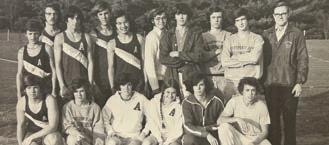
“I still play golf in a women’s golf league, but I’m also still involved in sports through my children and grandchildren,” Cooley said.
Although Serafin doesn’t currently play a sport, she is still active and supports her grandchildren in their sports teams.
However, while Title IX has made a large impact on athletics, there is still more progress to be made.
“I was excited about it, and I wanted everything to be equal,” Cooley said. “But I’m aware that it wasn’t a sudden change and it still needs to improve. Look at how long it’s been since the bill was passed; as far as I’m concerned, it’s not where it should be, but it’s definitely an immense improvement over not having it at all.”
Walsh agrees that the progress took time, and that there is still more room for improvement.
“I think the girls should be credited more than anyone else with the fact that they kept pushing and pushing; it took a long time and it wasn’t done overnight either.” Walsh said. “Now, I think the girls are fairly even, I don’t think they are fully even yet, but they are getting there.”

Algonquin Regional High School lost a kind, caring member of the community when junior Jon Niemi passed away unexpectedly but peacefully on Sept. 17, 2022.

Jon was born on July 1, 2006 and is survived by his parents, Katherine Niemi and Derek Niemi, his two younger siblings and his close friends. He left an impact on his family, friends, teachers and classmates, who have struggled with the loss and are thankful for the time they had with Jon.
Jon transferred to ARHS during the second semester of his freshman year from Assabet Valley Regional Technical High School. According to his father, Derek Niemi, Jon was a smart kid and a dedicated student. Some of his favorite hobbies included playing video games, biking and making videos on YouTube.
“He also liked playing games, like every other kid, and he liked YouTube in the last four or five years,” Niemi said. “He really started messing around with YouTube and he told me he really wanted to pursue that. He was getting pretty serious toward the end, really looking into how YouTube markets, back screen colors, how long a video should be. I was pretty impressed at how deep he went into it.”
Jon was especially close with his family, and enjoyed the vacations they took each summer to visit his cousins and spend time together.
“We used to go down to the Cape every summer,” Niemi said. “We would kayak out to the islands, hang out there and he’d jump off the bridge. There were a lot of memories. He especially looked forward to it and seeing his cousins the last three years or so. He really enjoyed that. We would rent golf carts; it was a private community and the kids would ride around on all the golf carts at night. We’d have a ping pong table, darts and all these other games
and have a tournament between all the adults and kids. It was a blast.”
One of Jon’s closest friends, junior Perrin LoRussso, has known Jon since the second grade. Some of LoRusso’s favorite memories with Jon were from the vacation to York, Maine they went on together in the summer of 2020.
“There was this beach and it had these stone stairs, but they were really big,” LoRusso said. “When it was high tide, the waves would come in and they would go super high in the air and we would sit there at the bottom and then when the waves came, we would run up to the top. That was fun.”
LoRusso described Jon as someone he could talk to about anything, as he was always very kind and supportive.
“He really was an amazing friend and an amazing person,” LoRusso said. “Everyone knew him as that.”
After transferring to Algonquin, due to his kind nature, he quickly made connections with classmates and teachers, including his U.S. History teacher, Greg DeCosmo.

“The first thing that comes to mind when I think of Jon is gentle and kind hearted,” DeCosmo said. “It’s different for me because I work with teenage boys. They’re usually rambunctious and crazy. It’s more rare for a young guy, a young man to be really kindhearted and a little bit on the quiet side. He had a gentle demeanor and an easy way about him.”
DeCosmo especially remembers Jon’s easy laugh and smile.
“He also had a really good sense of humor, like a smirk, a sideways grin that I saw all the time,” DeCosmo said. “You could joke around with him with dad jokes, or you could make risky jokes with him, and he understood all of it and would have this grin on his face the whole time.”
Jon also worked closely with his Special Education teacher, Caroline Flynn. According to Flynn, all of his teachers loved working with him and appreciated his kind, calm demeanor.
“Any teacher always thought he was just a lovely person,” Flynn said. “He had a calming effect on people. Jon never raised his voice or was openly demonstrative about anything. He would smile a lot.”
Flynn explained that although Jon was a private person, he was friendly and kind to everyone he talked to.
“He was just really a private kid, too,” Flynn said. “That calmness about him, about everything, was something that stood out. He was friendly with everybody. He was just a good person.”
After Jon’s passing, members of the Algonquin community sent letters to his family, expressing their condolences and including messages about Jon’s impact on them.
“Reading all the 50 letters that I have here, not one person said anything bad about him, or that they had heard anything bad said about him, which is amazing,” Derek Niemi said. “I think that really shows how pure his heart was.”


New math teacher Corey Pooler is eager to get involved with the ARHS community, through both academics and sports, as the new football kicking coach and middle distance track coach.
With a degree in mathematics from Westfield State University and experience working with students of various disabilities, Pooler is excited to teach high school math and coach after school.
“I like working with other people,” Pooler said. “I like exploring math; it’s an interesting subject and being a teacher fits my lifestyle.”
Although Algonquin is different from his previous school, Pooler enjoys the new environment and
JACLYN FAULCONER Staff WriterAlgonquin Class of 2012 alumna Sarah Weintraub has dedication and passion for her role as a new special education teacher and liaison for the RISE Program.
“If a student is going to have a bad day it’s going to be a more challenging day for me because I need to figure out the best way to help them,” Weintraub said. “The students that take the time to get to know me and are receptive to me getting to know them, I think we form a really nice relationship.”
Along with helping students navigate challenges, Weintraub has learned to focus on creating a healthy balance between her work and personal life.
“I love coming to work every day because of the students and they have a huge impact on me whether they know it or not because it models how my day goes,” Weintraub said.
According to Weintraub, the RISE is a program that offers specific help to special education students that offers additional academic and therapeutic support.
“[The RISE program] was modeled very differently last year, so this year it’s been a learning curve of how as a new teacher how can I set up a repertoire for my students but at the same time get my job done,” Weintraub said.
school culture.
“I love that sports are big, the musical is going on, the activity fair just happened, and everybody is super supportive and engaged,” Pooler said.

New Chemistry teacher Joshua Coulson is eager to make an impact at Algonquin and build relationships with his students.

“I love how [chemistry] helps peel back the layers of the world,” Coulson said. “When you look close enough, everything in the natural world can be explained. You just have to look hard enough. It fosters the curious.”
Along with his love for teaching and exploring chemistry, Coulson appreciates being able to interact and connect with students.
“Chemistry is not something I can change necessarily, but I can make it more interesting in a class-
room setting,” Coulson said. “I feed off [students’] energy and if they’re super bummed and bored, it impacts me, so I try to make it more interesting and have some jokes with it.”
New School Psychologist Brittany Flynn is ready to help all students access their full potential and become more involved in the Algonquin community.
After her experiences in higher education, Flynn knew she wanted to work with high school students.
“I have an easier time connecting with students in this age range specifically,” Flynn said. “My primary motivation, whether at work or at home, is if I can make one person’s life a little easier, then that’s enough for me.”
“I would like to serve as a presence, as a general
person that people could check in with,” Flynn said. “I welcome anyone at any time to come say hi and get to know me.”
New World Language teacher Agustina Harmon looks to share her culture and promote real-world language skills with students.

Harmon grew up in Argentina and has traveled through Latin America. She takes great pride in sharing not only her culture with her students but also the cultures she observed throughout her travels.
“As a native [speaker] that spoke [Spanish] all my life, I can bring not only the language but also the culture, and I think that’s a good connection,” Harmon said.
Harmon prioritizes sharing the cultural practices employed in different Spanish-speaking areas with her students.
“I think [learning a language is] important because [besides just] learning the language and being able to understand and to communicate you get to know about other cultures and you can make connections outside of your local circle,” Harmon said.
New special education teacher Katie Maguire has a strong passion for teaching students, specifically students with communication-related disabilities.
“I have always had a passion for working with kids,” Maguire said. “I have been an avid babysitter since I was nine years old, and wanted to work with kids at a very young age. Then I worked with a girl that had cerebral palsy for a very long time and that’s what got me into the special education world.”
As a teacher, Maguire’s job is to help her students learn and retain new subjects. Though this may seem challenging, she sees the bigger picture.
“[My students] love learning new things, which makes me enjoy teaching them,” Maguire said. “I love
the ‘ah-ha’ moments that my students get, and when they have more of those, I am inspired to teach.”
New math teacher Benjamin Burger is excited to educate and inspire at Algonquin.

After his senior year of high school, Burger worked as a counselor at Camp Woodhaven in West Boylston, Massachusetts, where his passion for working with adolescents began. Although he first majored in engineering at the University of Connecticut, his love for mentoring youth ultimately led him to switch his major.
“I really wanted to find a career that combined the two [mathematics and teaching],” Burger said.

Burger teaches Algebra II, Geometry and Individual Math at the college prep level, and works to establish connections with his students through his lessons.
“I really enjoy getting to know all my students,” Burger said. “Getting to know faculty members, administrators, counselors and all the new fun faces is definitely my highlight.”
SARRASIN News/Sports EditorNew World Language teacher Pauliny Smith begins the school year with a positive attitude as she strives for a welcoming learning environment and building connections with students.

Smith is a proud Brazilian-American woman who attended Assumption University, majoring in education and Spanish. Her fluency in English, Spanish and Portuguese allows her to connect with a diverse range of students.

“I have known I wanted to be a language teacher for a long time,” Smith said. “Growing up in my town [of Millis, MA], a small town that wasn’t very diverse, I always felt like I was hiding a part of myself and only speaking Portuguese at home.”
Smith’s background has shown her the importance of connection through language.
“Getting involved with another language opens up the doors to the world,” Smith said. “Language is important because there are so many people in America who originated from other countries, and so many people leaving America for countries [with other national languages].”
Read the full articles and more profiles here:
Senior Ben Schanzer, the first ever student council president to hold the position for two years in a row, utilizes his past experience as he emphasizes the power of collaboration and teamwork.
Before being elected Student Council President his junior year, Schanzer was the freshman class treasurer and he co-chaired the Student Council Policy Committee his sophomore year.
“I really have enjoyed over the last three years being able to work to provide a voice for students before the administration,” Schanzer said. “We are really, really lucky to have an administration that cares deeply about the student voice and actively seeks it out.”
Having the ability to give students a voice is what initially motivated Schanzer to participate in student government.
“Most importantly, for students who generally don’t have a strong voice or a place to use their voice, it’s really important to me that everyone has a
seat at the table,” Schanzer said.
According to Schanzer, because of the strong relationship between the Student Council and the administration, they have been able to work together to accomplish goals based on student requests.
“One of our biggest accomplishments was getting gender neutral bathrooms put into the school,” Schanzer said. “The effects that we can see are awesome. It’s really given a lot of kids a place they feel safe at school for something as basic as a human right as using the bathroom.”
Schanzer hopes to make a lasting impact in his last year as Student Council President.
“I want to leave behind a legacy of the student council that lasts a while,” Schanzer said.
Student Council adviser John Barry feels the Student Council does a lot of different things for the student body, which sometimes go unappreciated.
“I really don’t think [the student body] understands how many layers go into the things that the steering committees and the Student Council bring to them,” Barry said.

Because the Student Council strives to accurately represent the needs and wants of the student body, Schanzer encourages students to reach out with their thoughts through the Google Form available on the Student Council Canvas page.
“It really is our best resource to hear what everyone is thinking,” Schanzer said.
Senior class president Sarah Coldwell is working to lead her class to success in her final year in student government.
During her freshman year, Coldwell went to her first steering committee meeting as she searched for a way to make a difference in the world around her. This led her to become passionate about student government and she continued to participate at varying capacities all four years. First as a student council representative and now as class president, Coldwell takes pride in the impact she has helped make.
“[Student government] gave me that place to make a difference at school,” Coldwell said.
Coldwell prides herself on representing her peers and working as a team with her fellow steering committee members, who meet Thursdays in G112, as she leads the class.
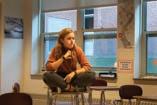
“It’s great to be able to be a voice for so many stu-
dents,” Coldwell said. “I am proud of the difference I’m trying to make.”
Her past experience in student government has taught her a lot about being a leader and representing the student body.
“I will definitely, this year, focus on trying to remain a neutral party and be a voice for students; because I might have my own opinions, but at the same time I’m supposed to represent the people at
our school and what they care about,” Coldwell said.
Senior class adviser Kerriann Lessard admires Coldwell’s organization and hard work. Lessard is glad this year is different compared to the past few years, as COVID-19 impacted the school’s ability to hold events and activities.
“She’s thinking a lot about how to make our last school year here a successful one and an enjoyable one,” Lessard said.
Coldwell, who was recently one of six students from around the state who was honored with an Equity Award for her work in the community and with Student Council, encourages all students to get involved with student government. From completing the surveys the steering committee occasionally sends out, to going to the steering meetings and running for an elected position, there are many ways to share ideas and make differences in the school.
“Steering is a great place for everybody to get their voice heard, not just elected positions,” Coldwell said.
Junior Class President Renee Gauthier, who has held her title as president for two years, works to be an encouraging leader and is determined to make this her best year yet.
Challenges such as having insufficient funds and the effects of the pandemic have given Gauthier valuable experiences that have developed her leadership skills.
“It’s almost like having more confidence when you’re in junior year,” Gauthier said. “You’ve done this before, you have more money, you have more funds, you have a committee that will stand by you and a lot of times there’s reelected members and representatives, so it makes it a lot easier.”
Gauthier’s proudest accomplishment so far was the planning and execution of this year’s Homecoming dance.
“[Homecoming] was our biggest [event] that we’ve done yet,” Gauthier said. “It was honestly one of my favorite things and it was pretty good, and I’m pretty proud of it.”
Junior class advisers Elisa Drake and Lorraine Zanini oversee Gauthier and the steering committee, guiding the students and supporting fundraising for events.
“[Gauthier] is organized, kind and people feel that

they can depend on her,” Drake said. Gauthier has recently prioritized increasing school spirit among the junior class.
“Over the past few years [school spirit] has dwindled down and not a lot of people want to participate in things,” Gauthier said. “It’s a little tough, but I feel like I’m slowly starting to see more.”
By hosting more in person events and encouraging participation on spirit days, Gauthier believes the amount of school spirit has and will continue to grow.
“Having the ability to do more things together, having more events, having more service, being able to connect with everyone,” Gauthier said. “Especially in those settings where you don’t have to distance yourself from people.”
During her time as president, Gauthier has learned exactly what it takes to hold the title of class president.
“The biggest thing that I have learned this year is that it is not all about talking in front of people,” Gauthier said. “It’s a balance, and you also need to know how to be able to lead a group and almost be a teacher in a sense when you’re doing those meetings.”
Gauthier believes student input is crucial to being a good leader and reflecting the needs and wants of the student body. Students can get involved by filling out surveys or even attending steering committee meetings.
“We have biweekly steering meetings on Thursdays,” Gauthier said. “We will send out information on when the days are and we will have posts on our Instagram about what we are going to do next.”
Drake believes Gauthier has proven to be a strong role model for her classmates.
“I think it’s her approachable nature,” Drake said. “People trust her.”
Gauthier has enjoyed her position as class president and has found her involvement to be fulfilling.

“When you spend so much time planning events and you work on it and you work with your group on it and then you finally see it happen, it’s so rewarding,” Gauthier said.
Sophomore Class President Nathan Meschisen is prepared to make improvements for his class, working with the help of the sophomore steering committee.
While he did not expect to win the election last spring, Meschisen has already found success in his new role. So far, he has taken on numerous projects and strengthened communications within his class.
“People didn’t think I was taking it seriously,” Meschisen said. “They thought I was doing it just because I could, but I actually wanted to help better our class and create a fun, open environment.”
Although this is Meschisen’s first year involved with the steering committee, he had thought about running for a position for a long time.
“I wanted to run freshman year, but I felt like I didn’t have the right voice to say anything and I wasn’t sure what I would do if elected,” Meschisen said. “I didn’t want to be someone who just sat at the meetings and observed; I wanted to actually be part of it. I wanted to have a strong influence so I could make my goals happen.”
Sophomore class adviser Kristen Morcone, who advises along with Nicole Ruffo, has high hopes for this year’s steering committee and Meschisen’s role in it.
“So far Nathan has been a great class president and leader,” Morcone said. “The meetings that he has run so far were very organized and all had great purpose. He comes with lots of ideas and does a great job of listening to his peers.”

Sophomore Vice President Tim Zhang feels this year is promising for their steering committee and
is impressed with Meschisen’s dedication to his new role.
“I think Nathan is a really good president,” Zhang said. “I like that he takes initiative and asks the right questions. He’s certainly not quiet, and he’s not arrogant either; he gets things done.”
Meschisen spends a lot of time engaging with his class and recruiting people to come to their steering meetings.
“I enjoy being able to advocate for the class, along with increasing participation,” Meschisen said. “The more people involved the better. My goal as class president is to engage with the student body as much as possible to get the most rounded answers possible.”
Operation Enduring Freedom may have a different name, but their mission remains the same.
The student organization, which supports military personnel, veterans and first responders through various activities, was previously known as Operation Tomahawk– the name of a Korean War military operation that took place in 1951. In correspondence with Algonquin’s mascot change, the club changed their name to Operation Enduring Freedom–the official name of the War in Afghanistan and the Global War on Terrorism, which occurred from 2001-2014.
“We decided on Operation Enduring Freedom because it honors former ARHS student Brian Arsenault, who died during the battle in 2014,” student club leader, senior Jaclyn Faulconer said.

Operation Enduring Freedom hosts many important events, such as the Murph Challenge, a military-grade workout that honors Navy Seal Lieutenant Michael P. Murphy, who received the Medal of Honor for his actions in the War in Afghanistan. The profits are donated to veterans retirement homes within the area.
“Last year was my first year doing the ‘Murph challenge,’” Faulconer said. “It was so much fun and I found it really cool because it showed me how much effort the military personnel put in for us.”
The challenge consists of a one mile run, 100 pullups, 200 pushups, 200 squats and another one mile run to finish. Participants can choose to wear either a 20 pound vest or body armor during the event.
“We hold many different events within Operation Enduring Freedom,” Faulconer said. “One of the most important events that we do, besides the Murph challenge, is our visits to veterans retirement homes every year.”
Operation Enduring Freedom visits Veterans Inc. in Worcester every year, where they serve dinner and spend time with the veterans.
“Most of the veterans are very open about their experiences,” Faulconer said. “I have learned that many veterans have not healed from their past trauma. Some veterans ask to be left alone.”
Operation Enduring Freedom holds an annual Veterans Day assembly. Social studies teacher and club adviser Gina Johnston encouraged teachers to allow their students to attend this year’s assembly, which was held on Nov. 10 and featured retired Army Command Sergeant Major Anthony Pittman, Staff Sergeant Wesley Ratliff and Marine Gunnery Sergeant Andrew Roberson, who spoke about their military experiences and why Veterans Day matters.
“It’s hard to get teachers in the building to allow students to go to the assemblies because we all
cherish our time with our students,” Johnston said.
Johnston believes these assemblies are great opportunities for students to gain a new perspective.
“If you’ve never met someone who served in the military, you don’t realize all the sacrifices that they have made so that you can live your life,” Johnston said. “They have seen horrors and they have done things that the rest of us could never imagine doing.”
Johnston wants students to know that despite the new name, Operation Enduring Freedom is the same organization with the same goals.
“Even though we changed our name, we still have the same mission of honoring veterans, military personnel and first responders,” Johnston said. “[Operation Enduring Freedom] will be there for anything that people need.”
Faulconer and Johnston encourage new students to join Operation Enduring Freedom. Meetings are every Wednesday after school in G102.

“We are open to new members every week,” Faulconer said. “You can just show up to any meeting.”
Operation Enduring Freedom has and will continue to honor veterans. It is their main goal to ensure that our community gives back to those who have sacrificed greatly for our country.
“Veterans are everywhere,” Johnston said. “Take a moment to thank them.”
This article was published in Nov. 2022 on arhsharbinger.com.
Algonquin’s new Brighten a Day Club, created by sophomores Emmy Beauchesne and Emma Thompson, is spreading positivity through acts of kindness.

Brighten A Day is a nonprofit volunteer organization, dedicated to spreading love and cheer through cards, gifts and small acts of community service. Beauchesne and Thompson decided to create an ARHS chapter to extend their mission of spreading smiles and bringing cheer to students, senior citizens and other community members.
Beauchesne and Thompson, both three-season athletes, created this chapter as a low commitment option for people wanting to help others. They wanted the club to be fun and less stressful while still helping the community and making a positive impact.
“Many clubs at Algonquin meet a lot and it’s hard to put in that amount of time commitment,” Thompson said. “Since many people have other responsibilities, we thought it would be a good option[for students].”
The club welcomes anyone looking for an extra source of positivity in their day.
“I think everyone could use something like this,“ Beauchesne said. “It’s not a necessity, but why not? A lot of people can be struggling with things such as anxiety at school or home lives [who can benefit from the club].”
Club meetings center around activities that spread positivity and give back to the community, but they
are also a time for students to socialize and have fun together. Later this year, they plan to create gift baskets for the holidays including cookie cutter kits and collect presents to give kids in the community who can not afford them. The club plans to create positive care packages for new moms to give them support.
“We are going to write letters to moms and attach a small rattle or gift to give them some inspiration so they know that everything will work out,” Beauchesne said.
At the club’s recent meetings, they have focused on creating cards for friends and teachers.
“Students could write to past teachers about their experiences with them and thank them for making their class enjoyable and interesting,” Beauchesne said. “It’s something to just cheer teachers up even if the student didn’t seem to pay attention or be interested that much [during their class].”
The club, which is advised by English teacher Alex Sliva, meets in H202 and communicates about meetings and events through their Instagram account @brightenaday_algonquin.
“On Instagram we will post before each meeting time and date,” Thompson said. “You don’t have to sign up before you come, you can just decide if you want to that day.”
With the amount of hardships present in today’s society, Beauchesne and Thompson believe that even small gestures and acts of kindness can have the power to brighten someone’s day.
“It’s nice to be able to reach out and do small things to help people if you know them or not,” Thompson said.
This article was published in Nov. 2022 on arhsharbinger.com.

(Top
(Middle) Sophmore August Costello shares his challenging experience of coming out as trans to his brother. “It makes me feel like maybe they only care about me because of who they see me as and not who I really am,” Costello said.

Sophomore Karma Bebawy connected her experience in a car crash to her childhood in Egypt. “I reflected on my past. I was born in Cairo, Egypt, and lived there for the first 3 years of my life...I also wondered what it would be like if I hadn’t moved here,” Bebawy said.


Sophmore
tells the audience about how culture and what it means to her.

have to love it.
matters
Senior Lili Torres has been playing bass since 2015, but lately playing bass for her band, False Prophecy, has been an outlet for her musical talents.
False Prophecy consists of Torres, Algonquin class of 2022 graduate Thomas Davis on guitar, senior at the Brimmer and May School Jack Nathanson on drums and vocalist and guitarist Kyle Duncan. Torres is the only current Algonquin student in the band, which had already been partially formed by the time she joined False Prophecy at the end of her junior year.
“I went up to say bye to Thomas because we had a class together,” Torres said. “He just invited me into the band. That’s when we all came together.”
False Prophecy hasn’t been able to perform live yet due to distance—Davis is in college and Duncan lives in Tennessee. However, they plan to tour the New England area in the coming summer.

“This past summer, we’ve been rehearsing, getting to know each other and writing songs,” Torres said.
The songwriting process is a collaborative one, but not one that Torres takes the lead on.
“I’m not very good at writing songs,” Torres said. “There was one song I wrote a bunch of lyrics to, and some of them were used. I think Kyle forgot about what I had written and wrote his own thing, but it works.”
False Prophecy currently has four songs released
ARHS Student: junior Savannah Staples, vocalist
Genre: Punk Rock
ARHS Students: junior John Oliveira, drummer & songwriter, senior Daniel Boush, vocalist & guitarist, sophomore David Allexenberg, bassist, sophomore James Trask, guitarist
Genre: Rock
on Spotify: “Ascend,” “Treachery,” “Flying Monkey” and their most recent release, “Flame.” Their full EP, “Zenith,” will be released mid-November.
Torres describes False Prophecy’s music as alternative metal rock.
“Usually when I play, I’m thinking about Flea from the Red Hot Chili Peppers,” Torres said.
False Prophecy got its name through a randomized name generator, and for a while, Torres wasn’t actually sure what the band was called.
“[Our group chat] was just called False Prophecy,” Torres said. “I was like, okay, I’m going to guess that’s the name of the band.”
Torres’s favorite part about being in False Prophecy is being able to create music with the other band members, who share her taste in music.
“They’re all really good musicians and I’m proud to be part of their band,” Torres said.
This article was published in Nov. 2022 on arhsharbinger.com.
ARHS Student: senior Shane Curran, drummer
Genre: Alt-Rock
ARHS Students: junior Elliott Yee, bassist, junior Oliver Kubik, saxophonist
Genre: Jazz

The magnetic atmosphere of 1930s New York came to the Algonquin stage as the cast and crew performed the classic Broadway musical “Guys and Dolls.” Three performances were held in the auditorium on November 17, 18 and 19.
The musical starred senior Daniel Boush, sophomore Viviana Lebel, senior Nathan Spadafora and senior Aidan Kane. The cast and crew, co-directed by science teacher Brian Kelly and theater teacher Paul D’Agostino, worked hard to put the entire show together in the weeks leading up to the performances.
“Right now, everyone has learned what they needed to learn, but nothing is in order,” Lebel, who played Miss Adelaide, said a few weeks before the show. “No one really knows how it all works together. We get the idea, but we’re going to start to do full act run-throughs and full cast rehearsals.”
For Kane, who played the lead role of Sergeant Sarah Brown, some of the most chaotic rehearsals became her favorite part of the entire process because of their unique ability to build relationships among the cast.
“I always reflect on it during tech week or during the show when it all comes together,” Kane said. “You had no idea that you created these bonds, and you can step back and say, ‘Wow, this is amazing.’”
This year has been unique for Kane due to playing a lead role.
“In all the shows I’ve been in in the past, I’ve been in ensemble work,” Kane said. “With my character this year, it’s been a little different, since I’m involved with a very specific number of people.”
Kane wasn’t the only one adjusting to the experience of being a leader. Having a lead role as a sophomore was new and nerve-wracking territory for Lebel, but she soaked up every second, even during the challenges that come with a lead role.
“I’ve never had a lead so it’s a lot more content, and I’ve never acted in a musical,” Lebel said. “My thing was always dancing and singing, but more background stuff.”
As for the musical itself, Lebel enjoyed the com-
bination of the layers of themes and ideas intertwined within the music and the storyline.
“Everyone was confused about why it was chosen,” Lebel said. “It’s a classic show so I really like it, but it has many outdated ideas. Now that we’re getting into it, it’s more about female empowerment and moving past those ideas. The music is great and there is a lot of humor and there are a couple of different plots that all tie together but [the characters] don’t really know it.”
The directors purposely chose “Guys and Dolls” knowing it would force the actors to work on something outside of their comfort zones.
“We are really trying to expose our students to what theater is, where it came from, and the history of it,” Kelly said. “How we can take an archaic title like ‘Guys and Dolls,’ something that sounds bad by today’s standards, and how we can really show that these shows have themes that persist, that people relate to and that are really current, and have a lot
of fun with a different genre.”
“Seussical,” the musical from last fall, was drastically different from “Guys and Dolls” in terms of the music, acting and overall themes embedded in the musical.
“Last year we did a very modern show, which was based on Dr. Seuss, and it had a lot of central themes that had to do with acceptance of individuals and how everybody has their own personality, and learning to appreciate that and accept all of that,” Kelly said. “This year, it’s different from a thematic musical. This year we’re doing a classic book musical. We think about doing this show in much the same way that English classes would read a classic book.”
Despite the challenges that presented themselves in adjusting to a musical like “Guys and Dolls,” Kane finds that it wasn’t quite as hard to rehearse for as “Seussical.”
“Last year, ‘Seussical’ was all over the place because it was just such a difficult show,” Kane said.
“And I feel like people this year have this show a little bit closer to their heart. It’s just a show that’seasy to love.”
As a senior, this show caused some bittersweet feelings for Kane after participating in theater productions for all four of her high school years.
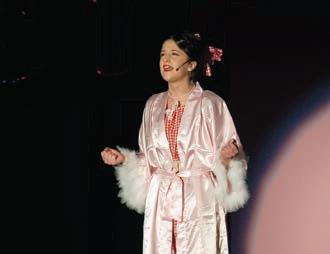

“I feel like I’ve grown as an actor in each one of those shows,” Kane said. “But I’m also sad because this is the last time I’m going to be working with the directors and some of these people. But I know I’m leaving the theater department in good hands, so I’m excited to see what comes next.”
The pit orchestra, which accompanied the performers during the acts, is led by Fine and Performing Arts teacher Eric Vincent. The group rehearsed every Tuesday for multiple hours after school.
“I like the music for this musical,” junior baritone saxophone player Juliana Oyola said. “However, I do think any show music is challenging.”
According to Oyola, performing as a part of a group is much less daunting than performing solo, something she has experienced as a musician since the fifth grade.
“I’m just very excited to see how it all pulls together in the end,” Oyola said. “My favorite part is being included in a community.”
The set design team was co-headed by junior Autumn Stewart and senior Alexander Reineke. Their job was to help design, build and paint the set, as well as get an overall view of the musical from an


artistic standpoint. “This year is a much more mature musical,” Stewart said. “It’s a lot more toned down in the colorfulness, but it’s arguably easier to work on than ‘Seussical’ was.”
The stage management team consisted of senior Ben Schanzer, junior Adam Guggina and Stewart, who attended rehearsals, took notes, and helped direct the backstage, such as the flow of props.
“I love seeing how the show comes together,” Stewart said. “Especially the backstage crew, how they get everything set and ready.”
Props master senior Camilly Fernandes prepared for the show by choosing, designing, making or acquiring all of the necessary props. She then organized the props backstage and assigned them to people who used them.
Before the opening Fernandes stressed how being in a time crunch was stressful.
“Time is essential and we don’t really have a lot of it,” Fernandes said. “We started the process about four weeks before we open the show so it doesn’t leave us a lot of time to do everything that we need to do to get all of the props ready.”
For the directors, collaborating and trying to merge all of their ideas was challenging, but they loved the challenge.
“With three sets of directors, the choreographer, the stage directors, and the vocal director, one of the biggest challenges with putting together a production is just aligning all of our own visions and then compromising with each other to get a show that is representative of each of our talents and our unique skills,” Kelly said. “We all have a very different skill set and a different way of looking at it, so we have to really come together.”
Though the producers were allowed to extend rehearsal times, they understood that everyone had other activities they need to complete each night after their three-hour afternoon rehearsals.
“Honoring them as performers and as students is really important,” vocal director Olivia Goliger said.
The musical itself has history at Algonquin.
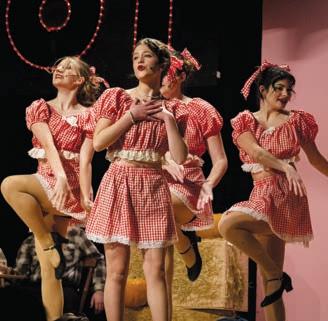

“I was in the show when I was at Algonquin and Ms. Goliger’s mom was the choreographer,” D’Agostino said. “This show does have Algonquin roots. There’s a lot of nostalgia in this process for us all. It’s interesting to revisit it twenty-two years later in the same room. Both triggering and interesting.”
For Kelly, the most enjoyable part of the process was seeing the musical come to life.
“I’ve always really enjoyed the idea of taking something off of a page and putting it on the stage so that people can see our interpretations and so that actors can get the chance to have fun with characters,” Kelly said.
This article was published in Nov. 2022 on arhsharbinger.com.
Taylor Swift’s tenth studio album, “Midnights,” is unlike any of her previous work and comes together to tell stories inspired by Swift’s insomnia.
“Midnights” was released on Oct. 21. Swift first announced the album’s release at the Video Music Awards on Aug. 28 and revealed track titles one by one on her “Midnights Mayhem with Me” series on social media.
The album opens with “Lavender Haze,” a track inspired by the retro 1950s sound. According to Swift, “Lavender Haze” was a common phrase used in the 50s to describe being in love. Many of Swift’s lyrics, including “I’ve been under scrutiny/You handle it beautifully” in the pre-chorus, describe how she dealt with rumors about her current relationship while still being in love. With lots of synth instrumentals and a catchy beat, “Lavender Haze” accurately reflects the rest of the album, making it the perfect opening track.
“Maroon,” the second track on “Midnights,” caught the attention of fans when the title was first announced. Swift’s fourth studio album featured a track two titled “Red,” and “Maroon” can be interpreted as a more mature version of the heartbreak narrated through “Red.” “Maroon” is far less upbeat than “Lavender Haze” and demonstrates Swift’s songwriting prowess through its metaphors (“Carnations you had thought were roses, that’s us”) and vivid imagery.
The third track and first single, “Anti-Hero,” is a raw account of Swift’s insecurities. The music video premiered eight hours after the album was released. A notable scene in the video symbolizes Swift’s body dysmorphia and criticism from the media, with imagery of her stepping on a scale and seeing the word “FAT.” However, due to criticism stating that Swift invalidated the experiences of the fat community, this scene was edited. It remains a controversial topic, as it was supposed to be a vulnerable moment but resulted in censorship.
The album consists mainly of solo songs because it shows Swift’s loneliness in the middle of the night, but Lana Del Rey collaborated with Swift for “Snow on the Beach,” the only feature. The use of imagery and layered vocals in the song makes it one of the best on the album. Although we would have liked to hear more vocals from Del Rey, the harmonies and vocals between Swift and Del Rey were beautiful and essential to the song.
The eighth track, “Vigilante Sh*t,” is definitely the standout song of the album. Immediately, the bass and beat with the presence of the synth create a
dark, powerful tone. Her metaphors and cold delivery of each line make the song empowering for listeners. This song and beat remind us of Billie Eilish, more specifically her song “you should see me in a crown” due to its metaphors and the overall sound. This song is definitely going to be a popular song, for good reason.
“Bejeweled,” the ninth track and second single, is the most upbeat song on the album, with lyrics that reflect Swift’s confidence. Its music video tells a Cinderella-inspired story, with Swift as a servant who transforms into a (bejeweled) princess and wins a proposal and castle from a prince. Ultimately, Swift ghosts the prince and keeps the castle for herself.
The standard album consists of 13 tracks, closing with “Mastermind.” It was the first track title announced and was probably one of the most anticipated songs, as 13 is Swift’s favorite number. In “Mastermind,” Swift describes her relationship by saying “none of it was accidental” and that “it was all by design.” Melodically, “Mastermind” has layered vocals and an upbeat tone for the verses but gets darker during the stripped back chorus.
“The Great War” is the 14th track on “Midnights (3am Edition)”, which was released three hours after the album and features seven new tracks. Unlike the standard album, which was mainly produced by Jack Antonoff, “The Great War” and some of the other “3am tracks” were produced by Aaron Dessner, giving them a more upbeat feel. The military drums align with the title, making the song feel more cohe-
sive. With a catchy beat and clever lyrics, “The Great War” is a great way to start the bonus tracks.
The 19th track on “Midnights (3am Edition),” “Would’ve, Could’ve, Should’ve,” is strategically placed, with the number 19 being referenced multiple times in the song. “Would’ve Could’ve Should’ve” describes a relationship Swift had at age 19 that continues to haunt her and credits it for the loss of her childhood and innocence. Swift’s songwriting shines in this intense track, set to a fast-paced beat that builds to a powerful climax.

The final track on the 3am Edition is “Dear Reader,” which opens with a steady beat and slow, echoing vocals. Both the title of the track and its repetition of the phrase “dear reader” references Charlotte Brontë’s novel “Jane Eyre,” giving the song a sophisticated energy. While “Dear Reader” is not a standout track on “Midnights,” we think it’s a great closing for the album. Swift advises the listeners to “Never take advice from someone who’s falling apart,” again referencing her insecurities.
“Midnights” has already broken so many records, as it is the album with the most first-day streams and physical sales this year. This is impressive, especially considering that Swift has been in the music industry for so long. Overall, we are happy with this album and can’t wait to see what Swift does next.
A longer version of this review was published in Nov. 2022 on arhsharbinger.com.
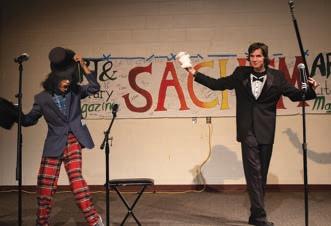
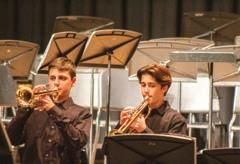
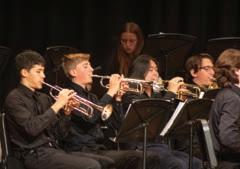
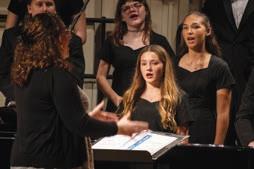

JID digs deep into his past and proves his artistry on his newest album “The Forever Story,” released on Aug. 26.
After four years since his last full-length project, Atlanta-based member of J. Cole’s rap label Dreamville, JID finally released his highly anticipated album. After constantly building up hype surrounding this project through features on Dreamville’s “Revenge of the Dreamers 3” and Doja Cat’s “Planet Her,” he does not disappoint in the slightest.
“The Forever Story” continues and improves upon the 2017 prequel to this album, “The Never Story.” It pairs his top of the line rhymes and flows along with intricately woven instrumentals. However, he brings more than just technical skills this time around, delivering one of the most thematically rich and lyrically profound projects of the year, exploring his upbringing and the relationships within his life.
“Galaxy,” the first track on the project, serves as a nice introduction with smooth vocals over a warm piano melody, very similar to the intro “Doo Wap” off of “The Never Story.” This soft atmosphere is contrasted by the next track “Raydar,” which immediately comes in with punchy 808s alongside JID’s witty wordplay. The beat then switches to a dark moody piano, paired with faster delivery diving into more substantive lyrics exploring JID’s ego and perception of himself.
Two tracks off the album were singles released earlier in the year, each serving as tastes of the album and showcases of his improved rapping ability. On the hit single and sixth track “Surround Sound,” JID fires a constant stream of alternating flows, as he rides the fast-paced sample based trap instrumental, which eventually shifts to a groovy and mellow bass-driven beat. In addition, 21 Savage delivers a phenomenal feature, filled with the clever lines and rhyme schemes that he has become known for.
The second single released in August, “Dance Now” featuring fellow Atlanta rapper Kenny Mason, gives listeners a treat as JID utilizes his unique talents, such as doing voice inflections, to emphasize certain themes of the song like temptations, sinning and “dancing with the devil”.
The eleventh track “Stars” features JID’s pitchedup rap vocals, floating over a wobbly synth with whimsical flute undertones, paired alongside chill lofi-esque drums. Lyrically, it reflects on his experience of trying to make it as a rapper in the industry, and the promises he made to keep people in his life while he was struggling.
JID does not forget about the artists grew up listening to, paying respect to other hip-hop legends in several lines on the album. “I used to wanna be Jay, I used to wanna be Wayne. I used to wanna be Kanye and Andre 3K.” Crazy enough, Lil Wayne was actually featured on the project, delivering a dynamic verse on the energetic twelfth track “Just in Time.”

This displays the distance JID has come since the start of his career, now performing alongside one of his idols.
The aspect that JID has improved on most compared to his former projects is his ability to express emotion. This change is seen clearly in the seventh track “Kody Blu 31,” which is a homage to his friend’s son named Kody, who unfortunately passed away. The song is essentially helping the mom of Kody to “keep on swangin’” and “keep her head high” in the face of grief. However, what makes this so emotionally present alongside the lyrics is his singing, which is surprisingly filled with passion and warmth. While almost every song on this album could be my favorite, the one that truly stuck with me was the fourth track, “Crack Sandwich,” which explores siblinghood and the importance of family, detailing the relationship between him and his parents during his youth. In the last verse of the song, he recalls the vivid story of a New Orleans street brawl that he was involved in, very reminiscent of the storytelling in one of my favorite hip-hop songs by fellow Dreamville member Saba, “PROM/KING.” These touching lyrics paired with a hypnotizing old school hip-hop instrumental and real audio clips from phone calls with family members make for a strikingly imaginative song.
After being under the shadow of J. Cole for far too long, JID proves himself to be more than just a promising rapper. He displays his incredible lyricism, flows, voice and range as not just a rapper, but a remarkably distinct musician. With this project, JID forms his own path stylistically, finds himself as an artist and ultimately breaks away from his other contemporaries, all while staying true to his roots as a humble Atlantan rapper.
This review was published in Sept. 2022 on arhsharbinger.com.

 RIYA MAHANTA & KATHERINE WU Managing Editor & Online Editor
RIYA MAHANTA & KATHERINE WU Managing Editor & Online Editor
This week on “The Voice” was the third week of blind auditions. Each week the performances seem to improve, so we’re excited to share our top five performances this week.

1. Grace Bello performed “Ghost” by Justin Bieber, earning herself a four-chair turn. Her voice was sweet yet powerful, showcasing her clever runs and peaceful tone. She sang the high notes effortlessly and emotionally, adding a level of sadness missing from the original song. Bello ended up choosing Team Cabello, a good fit as she sang pop and Cabello loves pop music.
2. Dia Malai sang “Real Love” by Mary J. Blige. She was energetic throughout her entire performance, hitting every single note. Legend turned his chair during the first verse, but surprisingly none of the other coaches turned. In our opinion, Malai deserved a four chair turn! However, we are glad she is working with Legend, as they are both soul artists, and we can’t wait to see more of Malai’s energetic performances.
3. Zach Newbould performed “Use Somebody” by Kings of Leon. Newbould is a phenomenal performer and an ARHS class of 2021 alum! We had been anticipating this audition for a while, and Newbould
delivered. He used his full vocal range effortlessly, displaying both smooth and raspy tones. This impressed both Cabello and Gwen Stefani, who were confused why the other two judges didn’t turn. We thought Stefani’s pitch was better, as she sounded more enthusiastic, but ultimately Newbould chose coach Cabello. Either way, it was exciting when Newbould talked about Northborough and featured a clip of Bartlett Pond in his video introduction.
4. Bodie sang The Fray’s “You Found Me” which earned him a four-chair turn. He has an edge in his voice and unique tone. During his performance, he had perfect pitch and he kept getting better, producing powerful vocals. He played the guitar throughout his entire performance, adding authenticity to his audition. As expected, Bodie chose Blake Shelton as his coach and we think this is a good pairing as Bodie’s tone has elements of Shelton’s.
5. Sisters Kasey and Lindsay Staniszweski, known as the Marilynds, performed “What If I Never Get Over You” by Lady A. Both of them have different sounds, but their vocals mesh well when singing together. The simple harmonies are beautiful, making them the best duo on the show right now. We are happy they chose Team Legend!
1. Kique sang “Hey Ya!” by Outkast for his performance, facing off against Rowan Grace and Destiny Leigh for a spot on team Gwen Stefani. He started off with low notes and a slow tempo, but in the chorus he sang with so much energy that we couldn’t help but dance. All four judges and the audience felt the same way, bopping along with Kique. His ability to connect with the audience through this performance was stellar. Kique surprised us, as his prior performances didn’t stand out much. We are excited to see what he can do during the live shows!
Additionally, Grace’s performance of “Vienna” by Billy Joel was too good to exclude. Only 16 years old, Grace delivered so much emotion and technique, allowing viewers to feel the song’s somber tone. Kique won this knockout, but thankfully coach Blake Shelton used his steal on Grace.
2. Representing team John Legend, Parijita Bastola performed “I’d Rather Go Blind” by Etta James, competing against Valerie Harding and Peyton Aldridge. Bastola poured her heart into this song, showing emotion through her tone and facial expressions. Her confidence, smooth runs and perfect high notes made this performance special. We believe that Bastola is the most consistent performer out of everyone this season.
3. On team Shelton, Bodie sang Post Malone’s “Better Now,” defeating The Dryes and Kevin Hawkins, although Hawkins got stolen by Stefani. Bodie transformed Malone’s pop hit into a production of his own, incorporating both blues and country elements. His detailed runs and soulful melodies truly connected him with the song, making the audience feel as if they were part of an intimate performance. Although Shelton had trouble choosing the winner, we believe that Shelton made the right choice.
4. For his knockout, Omar Jose Cardona performed “Radioactive” by Imagine Dragons, maintaining his spot on team Legend, sending Morgan Taylor and Ian Harrison home. Cardona’s passion and enthusiasm were unmatched. From the first line, we were able to see his unique ability to channel energy from his entire body into his voice. He delivered a concert-style performance proving to everyone the rockstar that he is!
This week on “The Voice” was the first week of the Knockouts. In past seasons, the Knockouts have been competitions between two contestants on the same team, but this year they introduced threeway knockouts. These three-way knockouts made choosing who advances harder than ever before.
5. On team Shelton, Kate Kalvach sang “Anyone” by Justin Bieber, competing with Bryce Leatherwood and Jay Allen. Her song choice showcased her beautiful, smooth tone, making the high notes seem effortless. Although Shelton chose Leatherwood to advance, both Legend and Cabello opted to steal Kalvach, with Kalvach picking Cabello as her coach. We are glad she was stolen, as she belongs in the live shows!
These knockouts were extremely competitive and made it nearly impossible to pick our top five. Stay tuned for more updates on “The Voice”!

Hi everyone! Welcome to my “New Music Friday” blog.
For those of you who do not know, on the Spotify app, a playlist is updated every Friday from one of Spotify’s playlist editors, and it is titled “New Music Friday”. This playlist consists of recently released music from all different kinds of genres. Every week, I pick my favorite three songs from the playlist to share with all of you. The New Music Friday playlist is definitely my favorite time of the week, and hopefully it can be yours too after reading along!
Top 3 from Nov. 4 (in no particular order)
One of my favorite artists, SZA, released the single “Shirt.” I’ve heard bits and pieces of it for nearly two years now, as the chorus was released early on TikTok in early 2021. This teaser, though much appreciated, kept me wanting more for months on end, so I was ecstatic to see it on the “New Music Friday” playlist.
Paired with the song, SZA created an intense, mind boggling music video. She starred with actor LaKeith Stanfield in a Bonnie and Clyde-like duo where the two stars went around wreaking havoc, destroying and killing people all around the city.
At first listen, “Shirt” is upbeat and catchy, but the meaning of the song is more easily understood after watching the music video. SZA emphasized feelings of heartbreak post-breakup. The use of blood was used to symbolize the pain that the end of a relationship leaves on a person.
I was in awe of this masterpiece of a song, and am impatiently awaiting an album to drop.
Chlöe, an R&B and pop artist, created “For the Night” with Latto. A lively beat is consistent throughout the entirety of the song, which is not a surprise with London on da Track as producer of the song. Chlöe sings about unreciprocated love and the struggles that come with an attempted relationship, while Latto comes in strong with a verse about self-respect.
Though it was a collaboration I didn’t know I needed, Latto and Chlöe most definitely did not disappoint.
Now, I’d be a fool not to include Baby Keem’s deluxe version of his debut album, “The Melodic Blue.” Keem added seven new songs with features from Don Toliver, Lil Uzi Vert and PinkPantheress. “high-
way 95” was truly a work of art.
Coming from a huge Lauryn Hill fan, Keem made one of the most interesting yet beautiful stylistic choices to include a sample from “Killing Me Softly With His Song” by the Fugees. The sample included just vocals from the Fugees hit, but it was the perfect addition to “highway 95” to give it a particularly sentimental feel.
The original album, “The Melodic Blue,” enhanced Keem’s talents as he’s often been stuck in the shadow of his cousin, Kendrick Lamar. Keem and Lamar have a great relationship, and if anything, “The Melodic Blue” helped emphasize that. The deluxe edition was a crazy surprise and “highway 95” will definitely be added to my favorites.
Picking three songs this week was so difficult. I have to mention that “Falling For You” by Ashanti, “SOMEONE ELSE’S PROBLEM” by Ruel, “Snowbank Blues” by The Backseat Lovers, “Mother” by Matt Maltese and “PPL” by DRAM and BJ The Chicago Kid were also highlights from this week’s “New Music Friday” playlist. I highly recommend giving all of these a listen. What a wonderful week!
This blog was published in Nov. 2022 on arhsharbinger.com.
The new Titan mascot, adopted last February, has pushed students and athletics to modify old traditions for this school year.
Students voted for the new official mascot, the Titan, last February after the previous Tomahawk mascot was retired in 2020. As the 22-23 school year is the first with the Titan as a mascot, new adjustments have already been made to accommodate it. These changes were evident at the first football game on Friday, Sept. 9, where instructional support aid and football coach Jon Cahill described the enthusiastic student section as a showcase of the school’s spirit and support for the new mascot.
“I definitely noticed [students] chanting ‘Let’s go Titans’,” Cahill said. “Last year we didn’t get that because the mascot was sort of in limbo. We had retired the Tomahawk, but we hadn’t adopted a new mascot until the spring, so hearing it in the stands on Friday night was cool.”
The cheer team, who typically leads the student section during football games, also noticed the positive atmosphere surrounding the Titan mascot.
“I was surprised,” junior cheer captain Maggie Gorman said. “I did not expect the student section to drop the T-Hawks so fast, but they were cheering for the Titans during the game, and I was kind of
shocked.”
The cheer team had to adjust cheers to generate excitement and pride around the new mascot. According to Gorman, she has seen a noticeable shift in how the school views the Titan mascot from its initial reveal in February to now.
“The day that [the mascot] got switched, we had to start using ‘Titans’ in our cheers, and no one really liked it too much,” Gorman said. “Now, I think some people still have to get used to it, but honestly, there has already been a lot of progress so far.”
Additionally, the football program has made efforts to rebrand to the Titans this school year, including brand new uniforms and an increased social media presence. Over the summer, coaches launched fundraisers to afford the new uniforms, and Cahill believes that these changes are valuable.
“Having the Titan logo on our uniforms really makes it feel like it’s our mascot and it’s part of the team now,” Cahill said.
Many students were wary of the change in mascot when it was first announced, and some of those feelings continue to linger. Due to positive, but still mixed, student reactions, senior and student council member Elenna Peroni understands the tension between tradition and change within the student body.
“The mascot unites the school as a whole,” Peroni said. “The Tomahawk was a tradition, and it’s been
here since the school was built. So now the Titan mascot just has to top the old one to get everybody on board.”
As an Algonquin alumni, Cahill has witnessed the evolution of the mascot firsthand, but feels that the general school spirit has remained the same in all areas, even outside of athletics.
“We have always had a strong school spirit here at Algonquin,” Cahill said. “I was even voted most spirited when I was a senior. Back then it was the Tomahawk, and now it’s the Titans, and I just think that having that school spirit is a huge part of Algonquin, like going out to sporting events, musicals, concerts and showing support for fellow classmates. Having this new mascot allows us to create new traditions. It’s exciting for everyone.”
Although the efforts made by the Algonquin community to incorporate the new mascot into school culture are clear, Cahill believes that there is still more to come.

“I think we are just seeing the start of it,” Cahill said. “The sky’s the limit with what students here can do with their creativity. I’m excited to see what students can come up with to embrace this new mascot even further.”
This article was published in Oct. 2022 on arhsharbinger.com.
This year’s team captains are seniors Jack Battles, Mark Cayer, Gavin Moran, Ben Schanzer and Luke Trask. Battles reflected on the team’s season as well as their postseason goals.
What has led to your team having a strong season thus far?
“Younger guys stepping up. Our team is very young and that has led to our success as well as the main training over the summer which is the main focus. If you train over the summer, you’ll be ready for that fall season.”
What is your team dynamic like?
“Since our team is so large, since there’s no cuts, we often have different groups but we are very close…In general we have pasta parties in groups that we stretch in before and after practice. For a big team, we’re really close. This continues throughout the school year especially since I’ve been on the team for four years…. I’ve become friends with many of the guys.”
What runners have especially stepped up this season and how?
 GRACE BOUZAN Assistant Sports Editor
GRACE BOUZAN Assistant Sports Editor
The boys’ cross country team won the CMASS tournament on Oct. 29 after placing first at the Midland-Wachusett League Meet on Oct. 22. The team finished sixth in Division IB at the State Meet on Nov. 11 and qualified to run in the AllState Meet. Junior Aiden Ruiz led the team at States with a 16:42 time, placing 27th. At the All-State Meet, the team finished 18th in Division I with junior Joe Lamburn placing 69th and Ruiz in 76th.
The girls’ cross country team earned the title of Central Massachusetts District E champions after their victory at the league-wide meet on Oct. 29 at the Gardner Municipal Golf Course.

The top ten athletes from ARHS competed in the meet, scoring a total of 48 points and placing first out of the 12 schools present. Scores are calculated by adding the numerical values of the top five places held by one school. Junior Brigid Purcell placed second out of 76 runners with junior Olivia Guckian in fourth.
This year’s team was led by senior captains Ada Gebauer, Jula Utzschneider, Olivia Vitorino and Elly Beauchesne. Gebauer, the only senior in attendance at the league meet, placed tenth. Throughout the season, she believes their positive team dynamic has led them to success.
“Our team cohesion is definitely a lot better than it’s been in the past,” Gebauer said. “Everyone sup-
“[Junior] Joe Lamburn has been our guy [this year] and he was our guy last year. He’s great… We also have young guys such as freshman Jeff Tan and sophomore Jonah Gould, as well as junior Matt Zhang…We have a really strong young core and the backbone of the team. I think it’s very important.”
What’s coming up for the team and how are you feeling about the postseason prospects?
“This [past] weekend we had our league meet, which means we ran against all the teams within our division, which is always exciting running against our rivals. After that our varsity [running] in states, which is definitely the biggest state that we will be running in as well as the most important for us as a team.… It’s definitely exciting looking at the sophomores and juniors that we have already, especially the freshmen that will be on one more year of training…[for the season] I think next year, even though I won’t be here as well as none of my fellow seniors will be, [the team] looks like it’s gonna be pretty darn good.”
A version of the article was published in Oct. 2022 on arhsharbinger.com..
11, finishing in 11th place. Guckian qualified as an individual to participate in the All-State Meet. While Gebauer noticed a great effort from every athlete, some went the extra mile to improve over the course of the season.
“Brigid Purcell is starting to shine through a lot, same with Sheila, her twin,” Gebauer said. “They’re both ‘PR’ing by [almost] a minute and working really hard to get up there.”
Although Gebauer did not compete in the state finals due to an injury, she planned to attend as a spectator. She believes that supporting each other and acting as a team, both on and off the course, is the most important aspect of an individual sport.
“Everybody is putting themselves through a level of pain,” Gebauer said. “You work hard through that pain together, and that makes you closer.”
ports each other and knows what everyone else is going through. You show up to practice, and everyone is working hard.”
The team completed the regular season with a record of 3-0-2 and ran in the state final, on Nov.
This article was published in Nov. 2022 on arhsharbinger.com.
Algonquin Hall of Fame soccer player and coach John Frederick has returned to the ARHS sports scene as the girls’ varsity soccer head coach.
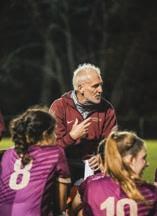
Frederick, an English teacher at ARHS since 1999, has years of experience as a player and as a championship-winning coach of the ARHS boys’ varsity soccer team (with a brief stint as the girls’ junior varsity coach last season), as well as being a former member of the New England Revolution Development Academy staff. Frederick hopes his experiences help the team achieve a memorable season as the fourth-ranked Titans advanced deep into the State Tournament.
“In the end, I hope, regardless of wins and loses and how far we go, whenever it ends, it ends as a result of great comradery and a team that cares,” Frederick said.
Frederick was a player on the Massachusetts State Championship winning 1988 boys’ soccer team as a junior. He returned to ARHS to coach the boys’ team for 10 consecutive years, delivering another two State Championships in 2004 and 2005, and winning a district championship in 2006.
“We had ridiculous players; we just had really talented players that were also tremendously fun to be around,” Frederick said.
Frederick gives credit for the success to his players, and he believes anything is possible with dedicated, talented players.
“Any coach that thinks they are the primary reason that they win, I think is missing the bigger picture; you need players,” Frederick said.
After coaching for 13 years at the New England Revolution Development Academy, Frederick returned to coach the ARHS girls’ junior varsity soccer team in 2021.
“When the varsity position opened up, I thought it was a natural fit so I applied and I was fortunate enough to get the job,” Frederick said. “It’s been, if not the greatest coaching job I’ve had, it’s certainly one of them.”
As the girls’ varsity head coach, Frederick strives to inspire a new generation of players using his pre-
After an immense effort and undefeated regular season, the girls’ varsity soccer team lost 1-0 to Hingham High School in the Division I State Finals on Nov. 19.
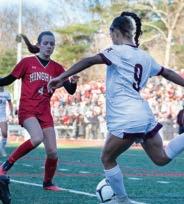
The game remained competitive throughout, with both teams making impressive plays, including Hingham’s goal in the first half. Algonquin maintained possession for much of the second half, increasing their offense and making several attempts at the goal before time ran out. A large student section filled the bleachers of Walpole High School to cheer on the Titans as they vied for the state title.
vious experience.
“This girls’ team is very similar to those [past championship] teams in a lot of ways,” Frederick said. “They’re a tight group, they care about each other, they’re fun to be around and they work hard.”
Frederick enjoys coaching at Algonquin and building connections with players, especially when he has the opportunity to interact with them throughout the school day.
“[At Algonquin], I get to know the players better,” Frederick said. “Because I’m teaching in the building, I see them for more than two hour [practices].”
This year’s team is made up of 26 girls, including 10 seniors. According to Frederick, many of the players have been close their entire lives. Frederick notices this connection and believes his players can handle whatever challenges are thrown at them.
“They’ve been friends forever,” Frederick said. “I just think it’s a group with tremendous personalities; there’s just so many different very big personalities in the group, they make me smile every day I’m out there.”
Frederick understands the struggles his players may face on and off of the field and works to create a comfortable environment.
“In the end, sports are supposed to be fun, and if they’re not fun, I’m not sure why we’re doing it,” Frederick said.
This article was published in Nov. 2022 on arhsharbinger.com.
The team ended the season with an overall record of 16-2-6 and was led by senior captains Mia Lochhead and Sadie Candela. Despite the outcome of the match, they were proud of their team’s performance in their last game together.
“I think we played our style of soccer very well,” Candela said. “We had a lot of possession, and even though we couldn’t get [the ball] in the back of the net, our goalie, Keely Scott, made some amazing saves.”
Scott, who blocked two Hingham shots in the second half, believes that the teams’ success this season is directly tied to their love of the game.
“There’s a lot of pressure to be the best and compete the best… but one thing that I try to apply to my game is just having fun,” Scott said. “I don’t really think that you’re able to play well

Throughout the season, the team has focused on strategy and how to adapt to their opponents’ style while playing to their own strengths. Coach John Frederick prepared his athletes for the state championship with individualized game plans.
“We talked a lot about our shape and how we wanted to defend against certain players,” Frederick said. “In the end, it was just about us being us, sharpening up our skill set and making sure we were ready to go.”
Senior Katie Cullen prepared for the state match by observing the rival offense, in order to better understand how they function and what to expect.
“The night before, I watched the last game [Hingham] played online because Hingham has a really good [player],” Cullen said. “Since I’m a center defender, I was going to be on her. I watched the way she played, and was able to prepare and realize what she does as a player.”
On their road to the State Finals, the No. 4 ranked Titans defeated Durfee and Framingham before a 3-0 quarterfinal win against No. 5 Newton South and a 2-1 win over No. 9 Wellesley in the Div. I State Semifinals on Nov. 16.


Frederick is proud that his team played their best and enjoyed themselves in the process.
“All season long, it’s been a massive priority to remind ourselves why we play the sport,” Frederick said. “Sports are supposed to be fun, and I think sometimes that gets lost
when there’s too much focus on results and winning or losing.”
Frederick has no regrets about this season and will miss the good times they had together as a team.
“There were some hiccups along the way, but I’ve been coaching for 30 years, and I’m not sure I’ve ever had more fun coaching a team,” Frederick said.
(Top right) Senior Sadie Candela dribbles the ball around a defender at the Division 1 Championship on Nov. 19, 2022. PHOTO ANNA BELLVILLE (Bottom left) Senior Gabriela Miranda gets ready to cross the ball under pressure in the Massachusetts state finals in Walpole on November 19, 2022. PHOTO COLIN KEARNEY LILA
LILA
The girls’ varsity volleyball team won the Central Massachusetts Championship on Oct. 29 with a 3-0 win over Wachusett. The season officially came to an end on Nov. 8 after losing 3-1 against Newton South during their second playoff game.
The team was led by senior captains Nina Viswanathan and Mia Dobosh. Dobosh recounts players feeling determined yet humble as the team entered the CMASS finals game against Wachusett.
“It was never an expectation to win but it was never a ‘We can’t do it’,” Dobosh said.
The team entered the State Tournament ranked 14th and defeated Wellesley 3-1 before their Round of 16 loss to Newton South.
Dobosh and Viswanathan both agree that the team’s bond largely contributed to such a great season.
“We just clicked as a team,” Viswanathan said. “You can play hard and be good, but it’s really the connections between your friends and teammates that matters.”
According to Viswanathan, the outcome of games varied on how clear their calls were and their outlook going into the game.
“We work with each other instead of trying to just personally improve,” Viswanathan said.
During the ups and downs of the regular season, the team used their performance during games to shape drills that they would use in practices to improve on weaknesses. Dobosh appreciated this opportunity for reflection, as it helped them better prepare for future games.
“After a game we would talk for five or so minutes about what we did well, what we did not do well, what we need to improve,” Dobosh said.
Throughout the season the team spent a lot of time together which helped build their comfort levels and develop supportive team chemistry.
“All of us had the same mindset of wanting a closely knit team that wanted to
do stuff before games and that was always encouraging each other whether you play every set or you don’t play,” Dobosh said.
Before the season started the captains ran clinics which helped the girls get to know each other and connect, which was beneficial in building an overall team.
“We don’t want it to be volleyball [broken up between] varsity, JV and freshman [teams] because it is the whole program, we are all in it,” Dobosh said.
Viswanathan and Dobosh both express great thanks to not only their teammates, but also to the coaches, Janice Henningson, Lisa Strom and Kristen Morcone, and the parents. Having parents at the games meant a lot to the girls and they recognize the dedication the parents put in to support the team.
Despite the season coming to an end, both captains are proud of how the team worked together this season.
“[Our] togetherness fueled our drive to win and play harder,” Dobosh said.
This article was published in Nov. 2022 on arhsharbinger.com
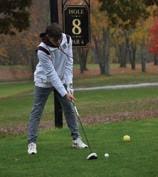
The 2022 boys’ golf season ended with a 9-7 record and the team finished in tenth place at the district tournament. The team was led by senior captains Chris Wittman and Jack Roberts. Roberts is proud of his team as he reflects on the season.
How was the season overall? What worked for your team and what did not work?
“We are happy with our season, we had a great group of kids and a lot of people returning. Seven out of our eight varsity players were upperclassmen, which is not typical because there are usually more underclassmen. Next year could be a little bit tough, but we are happy that we played well and we finished with a winning record.”
What is your team dynamic like and how do you work together?
“Even though golf is an individual sport, I think we play well together and communicate well. We help each other and [have good] team spirit.”
What players especially stepped up this season and how?
“[Junior] Brennan Rice. Two years ago he hadn’t played a ton of golf, but he practiced a ton this past summer and stepped it up and he’s been playing really well. He’s helped us win a lot of matches this season.”
What is coming up for the team and what do you think next season will look like?
“Next year we’re going to have a few returning kids that are now juniors and will be seniors. We’re going to have to recruit some new kids and some kids are going to need to step up. It will be an interesting year, maybe a bit of a rebuilding year, but I think it will work out well.”
This article was published in Nov. 2022 on arhsharbinger.com.
Senior Mia Dobosh and her teammates celebrate a point during the CMADA finals game. The Algonquin girl’s volleyball team beat Wachusett 3-0. PHOTO BETSY BERTONAZZI

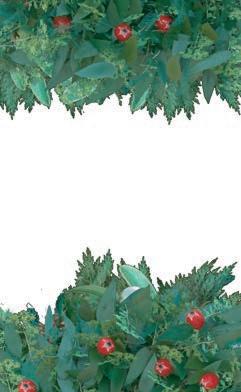










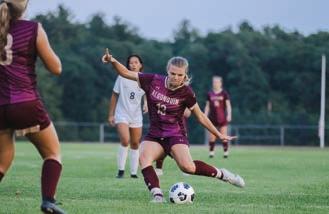

(Top) Sophomore Dylan Lochhead shoots on ActonBoxborough’s goal in the girls’ varsity soccer home opener on Sep 10. PHOTO JOE LAMBURN
(Middle left) The Algonquin girls’ volleyball team celebrates after winning the Central Mass Championship on Oct. 29. PHOTO COLIN KEARNEY
(Middle right) Sophomore Ella Poultney hits the ball over the net during the CMADA finals game on Oct. 29, 2022. The Algonquin girls volleyball team beat Wachusett 3-0. PHOTO BETSY BERTONAZZI
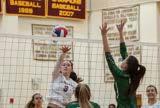
(Bottom left) Senior Matt Uzar gets surrounded while trying to get to the end zone against Catholic Memorial on Sept. 23. PHOTO OWEN JONES
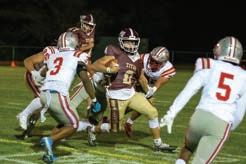
(Bottom right) Junior David Downey advances the ball up the field during the boy’s varsity soccer game against Leominster on Sep 8. PHOTO JOE LAMBURN
